

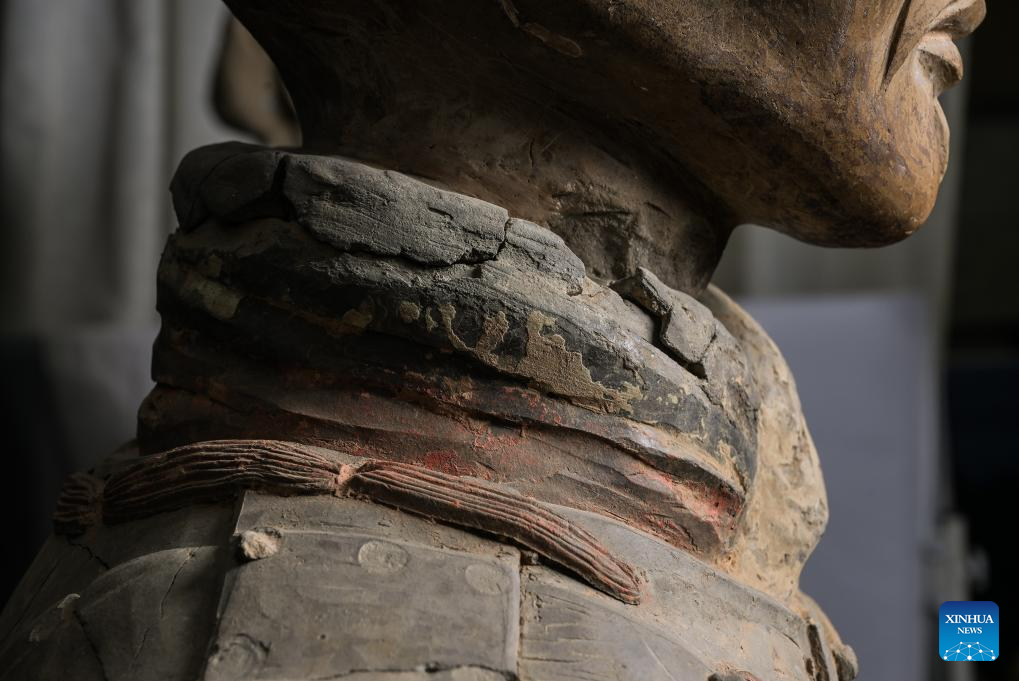
This photo taken on Aug. 23, 2023 shows a piece of the painted Terracotta Warriors at the Emperor Qinshihuang's Mausoleum Site Museum in Xi'an, northwest China's Shaanxi Province.
"We are the Terracotta Warriors specialists, and this room is a 'hospital' for the relics in the museum," said Lan Desheng, an expert in the restoration of cultural relics with the Emperor Qinshihuang's Mausoleum Site Museum.
Archaeological research shows that pigments have been found on the Terracotta Warriors. The painted layers of the Terracotta Warriors are very fragile. Once unearthed, with the changes of humidity and temperature, the surface quickly dehydrates and the painted layer comes off. In addition, microorganisms, soluble salts and other factors also cause the color fading.
According to Lan, shortly after unearthing, each painted Terracotta Warrior must go through X-ray detection, ultrasonic scanning, 3D images acquisition and other procedures. Staff members clean and restore the pieces of the painted Terracotta Warriors using slim bamboo slips, scalpels, small brushes, etc. Every Terracotta Warrior also has its own ID. In recent years, Lan and his team have completed the restoration of more than 140 Terracotta Warriors.
Discovered in 1974 and listed as a world heritage site by UNESCO in 1987, the army of Terracotta Warriors was built by Emperor Qinshihuang of the Qin Dynasty (221 B.C.-207 B.C.). (Xinhua/Li He)
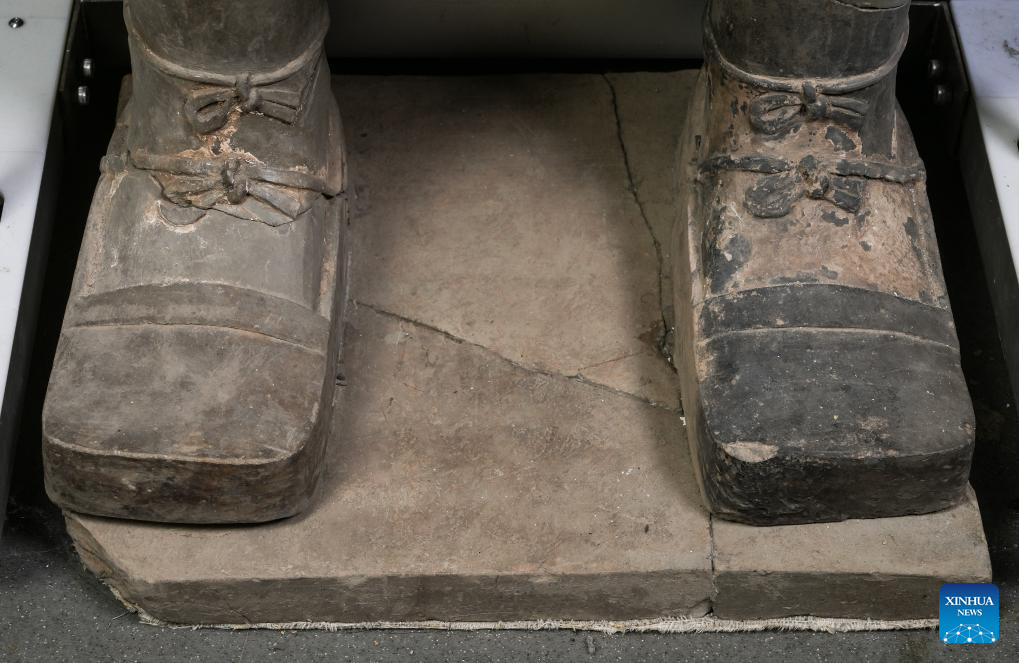
This photo taken on Aug. 23, 2023 shows a piece of the painted Terracotta Warriors at the Emperor Qinshihuang's Mausoleum Site Museum in Xi'an, northwest China's Shaanxi Province.
"We are the Terracotta Warriors specialists, and this room is a 'hospital' for the relics in the museum," said Lan Desheng, an expert in the restoration of cultural relics with the Emperor Qinshihuang's Mausoleum Site Museum.
Archaeological research shows that pigments have been found on the Terracotta Warriors. The painted layers of the Terracotta Warriors are very fragile. Once unearthed, with the changes of humidity and temperature, the surface quickly dehydrates and the painted layer comes off. In addition, microorganisms, soluble salts and other factors also cause the color fading.
According to Lan, shortly after unearthing, each painted Terracotta Warrior must go through X-ray detection, ultrasonic scanning, 3D images acquisition and other procedures. Staff members clean and restore the pieces of the painted Terracotta Warriors using slim bamboo slips, scalpels, small brushes, etc. Every Terracotta Warrior also has its own ID. In recent years, Lan and his team have completed the restoration of more than 140 Terracotta Warriors.
Discovered in 1974 and listed as a world heritage site by UNESCO in 1987, the army of Terracotta Warriors was built by Emperor Qinshihuang of the Qin Dynasty (221 B.C.-207 B.C.). (Xinhua/Li He)
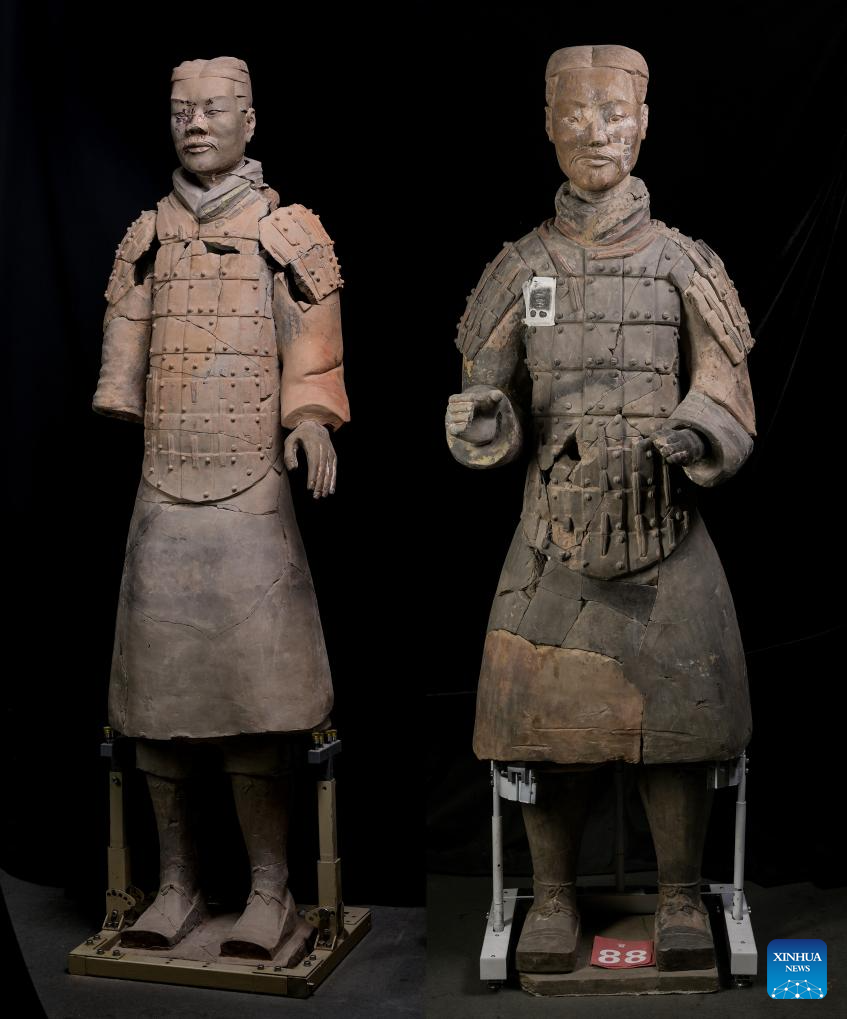
This combo photo taken on Aug. 23, 2023 shows two painted Terracotta Warriors at the Emperor Qinshihuang's Mausoleum Site Museum in Xi'an, northwest China's Shaanxi Province.
"We are the Terracotta Warriors specialists, and this room is a 'hospital' for the relics in the museum," said Lan Desheng, an expert in the restoration of cultural relics with the Emperor Qinshihuang's Mausoleum Site Museum.
Archaeological research shows that pigments have been found on the Terracotta Warriors. The painted layers of the Terracotta Warriors are very fragile. Once unearthed, with the changes of humidity and temperature, the surface quickly dehydrates and the painted layer comes off. In addition, microorganisms, soluble salts and other factors also cause the color fading.
According to Lan, shortly after unearthing, each painted Terracotta Warrior must go through X-ray detection, ultrasonic scanning, 3D images acquisition and other procedures. Staff members clean and restore the pieces of the painted Terracotta Warriors using slim bamboo slips, scalpels, small brushes, etc. Every Terracotta Warrior also has its own ID. In recent years, Lan and his team have completed the restoration of more than 140 Terracotta Warriors.
Discovered in 1974 and listed as a world heritage site by UNESCO in 1987, the army of Terracotta Warriors was built by Emperor Qinshihuang of the Qin Dynasty (221 B.C.-207 B.C.). (Xinhua/Li He)
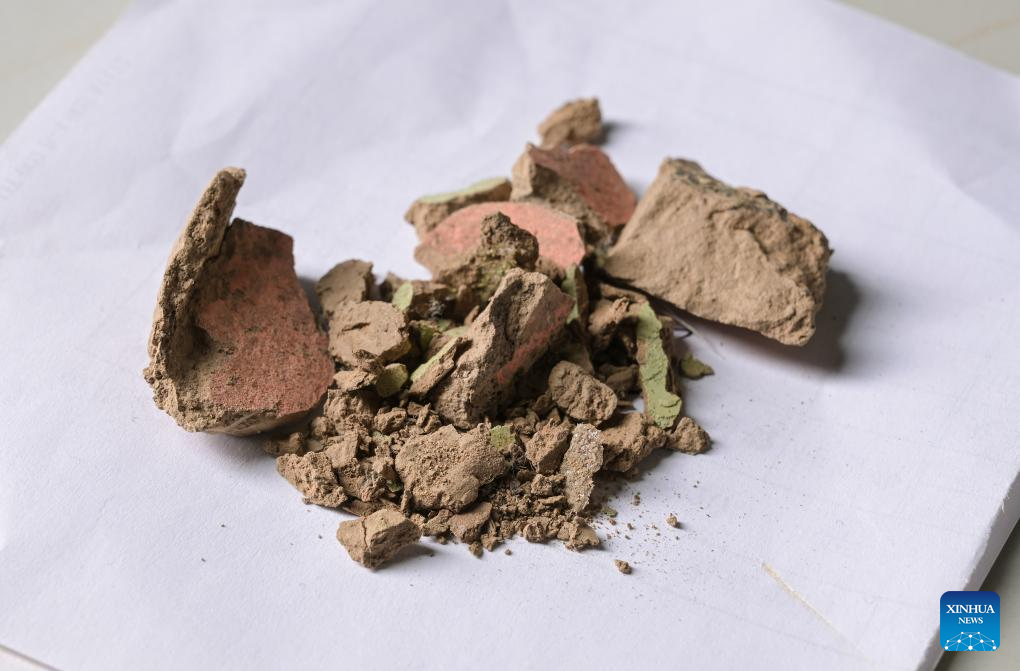
This photo taken on Aug. 23, 2023 shows painted clods to be restored at the Emperor Qinshihuang's Mausoleum Site Museum in Xi'an, northwest China's Shaanxi Province.
"We are the Terracotta Warriors specialists, and this room is a 'hospital' for the relics in the museum," said Lan Desheng, an expert in the restoration of cultural relics with the Emperor Qinshihuang's Mausoleum Site Museum.
Archaeological research shows that pigments have been found on the Terracotta Warriors. The painted layers of the Terracotta Warriors are very fragile. Once unearthed, with the changes of humidity and temperature, the surface quickly dehydrates and the painted layer comes off. In addition, microorganisms, soluble salts and other factors also cause the color fading.
According to Lan, shortly after unearthing, each painted Terracotta Warrior must go through X-ray detection, ultrasonic scanning, 3D images acquisition and other procedures. Staff members clean and restore the pieces of the painted Terracotta Warriors using slim bamboo slips, scalpels, small brushes, etc. Every Terracotta Warrior also has its own ID. In recent years, Lan and his team have completed the restoration of more than 140 Terracotta Warriors.
Discovered in 1974 and listed as a world heritage site by UNESCO in 1987, the army of Terracotta Warriors was built by Emperor Qinshihuang of the Qin Dynasty (221 B.C.-207 B.C.). (Xinhua/Li He)
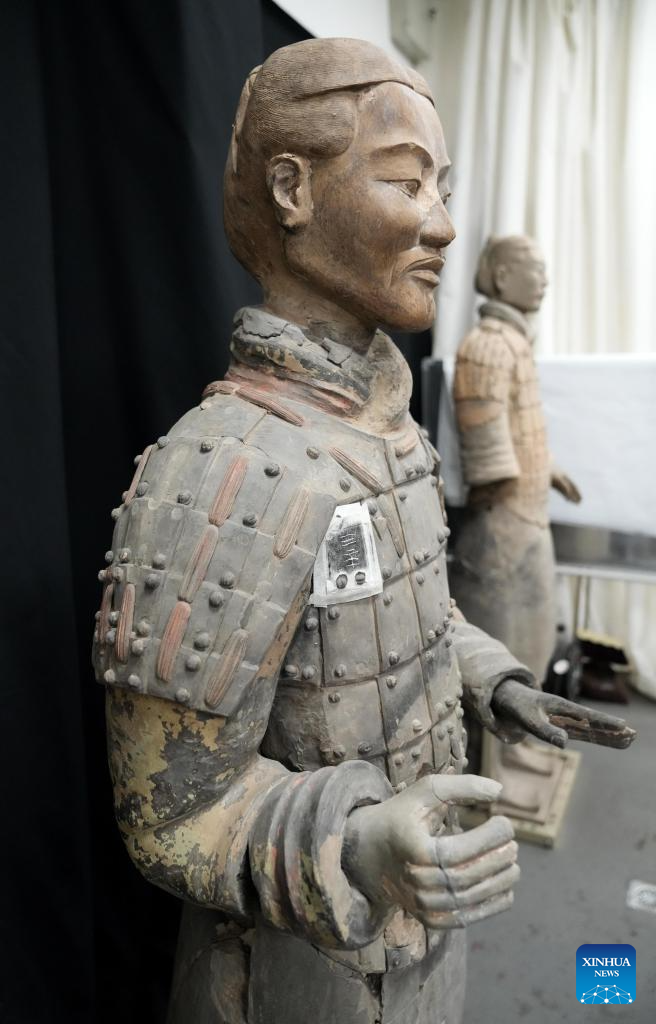
This photo taken on Aug. 23, 2023 shows a restored piece of the painted Terracotta Warriors at the Emperor Qinshihuang's Mausoleum Site Museum in Xi'an, northwest China's Shaanxi Province.
"We are the Terracotta Warriors specialists, and this room is a 'hospital' for the relics in the museum," said Lan Desheng, an expert in the restoration of cultural relics with the Emperor Qinshihuang's Mausoleum Site Museum.
Archaeological research shows that pigments have been found on the Terracotta Warriors. The painted layers of the Terracotta Warriors are very fragile. Once unearthed, with the changes of humidity and temperature, the surface quickly dehydrates and the painted layer comes off. In addition, microorganisms, soluble salts and other factors also cause the color fading.
According to Lan, shortly after unearthing, each painted Terracotta Warrior must go through X-ray detection, ultrasonic scanning, 3D images acquisition and other procedures. Staff members clean and restore the pieces of the painted Terracotta Warriors using slim bamboo slips, scalpels, small brushes, etc. Every Terracotta Warrior also has its own ID. In recent years, Lan and his team have completed the restoration of more than 140 Terracotta Warriors.
Discovered in 1974 and listed as a world heritage site by UNESCO in 1987, the army of Terracotta Warriors was built by Emperor Qinshihuang of the Qin Dynasty (221 B.C.-207 B.C.). (Xinhua/Wang Yuguo)
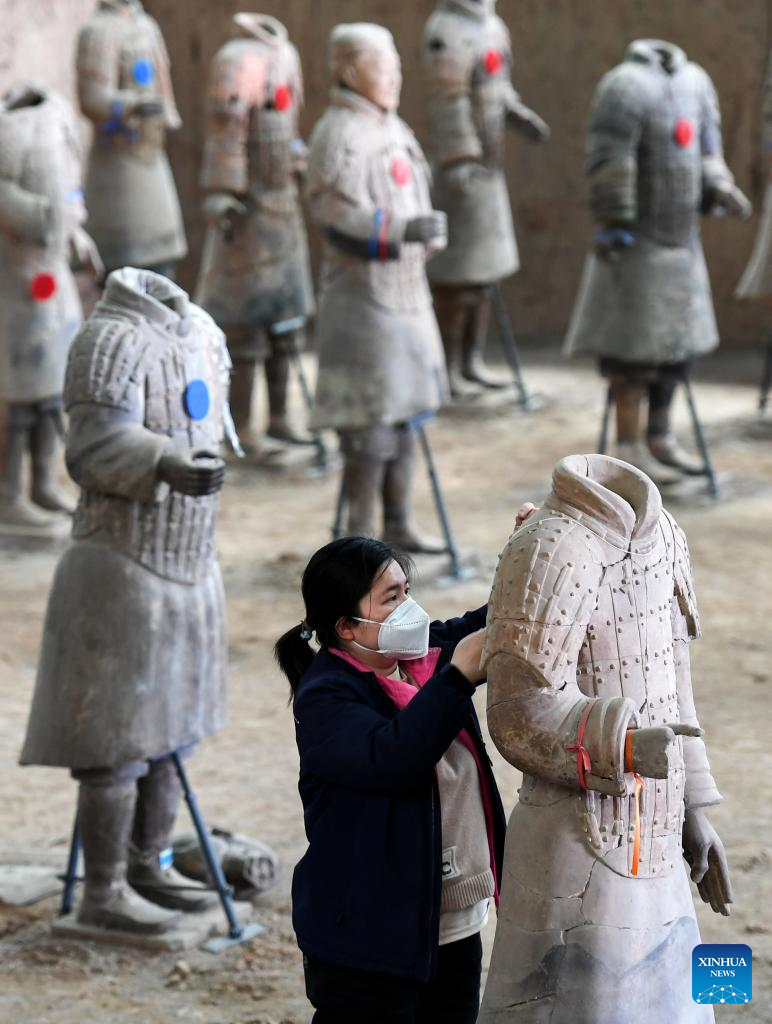
A staff member repairs a Terracotta Warrior at the pit No.1 of the Emperor Qinshihuang's Mausoleum Site Museum in Xi'an, northwest China's Shaanxi Province, April 26, 2023.
"We are the Terracotta Warriors specialists, and this room is a 'hospital' for the relics in the museum," said Lan Desheng, an expert in the restoration of cultural relics with the Emperor Qinshihuang's Mausoleum Site Museum.
Archaeological research shows that pigments have been found on the Terracotta Warriors. The painted layers of the Terracotta Warriors are very fragile. Once unearthed, with the changes of humidity and temperature, the surface quickly dehydrates and the painted layer comes off. In addition, microorganisms, soluble salts and other factors also cause the color fading.
According to Lan, shortly after unearthing, each painted Terracotta Warrior must go through X-ray detection, ultrasonic scanning, 3D images acquisition and other procedures. Staff members clean and restore the pieces of the painted Terracotta Warriors using slim bamboo slips, scalpels, small brushes, etc. Every Terracotta Warrior also has its own ID. In recent years, Lan and his team have completed the restoration of more than 140 Terracotta Warriors.
Discovered in 1974 and listed as a world heritage site by UNESCO in 1987, the army of Terracotta Warriors was built by Emperor Qinshihuang of the Qin Dynasty (221 B.C.-207 B.C.). (Photo by Zou Jingyi/Xinhua)
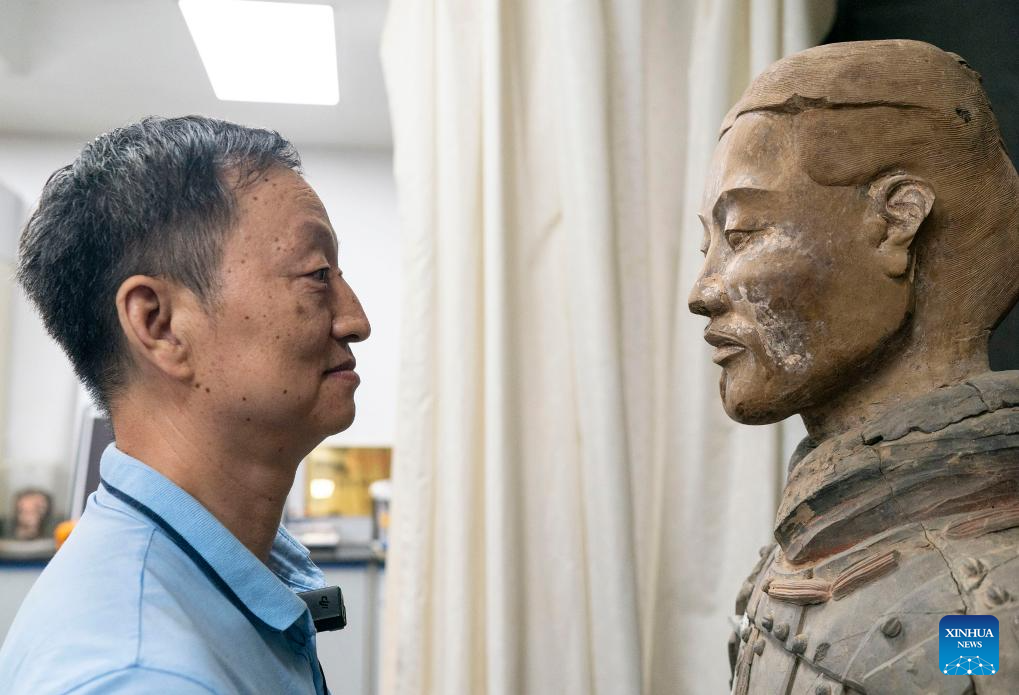
Lan Desheng looks at a painted Terracotta Warrior at the Emperor Qinshihuang's Mausoleum Site Museum in Xi'an, northwest China's Shaanxi Province, Aug. 23, 2023.
"We are the Terracotta Warriors specialists, and this room is a 'hospital' for the relics in the museum," said Lan Desheng, an expert in the restoration of cultural relics with the Emperor Qinshihuang's Mausoleum Site Museum.
Archaeological research shows that pigments have been found on the Terracotta Warriors. The painted layers of the Terracotta Warriors are very fragile. Once unearthed, with the changes of humidity and temperature, the surface quickly dehydrates and the painted layer comes off. In addition, microorganisms, soluble salts and other factors also cause the color fading.
According to Lan, shortly after unearthing, each painted Terracotta Warrior must go through X-ray detection, ultrasonic scanning, 3D images acquisition and other procedures. Staff members clean and restore the pieces of the painted Terracotta Warriors using slim bamboo slips, scalpels, small brushes, etc. Every Terracotta Warrior also has its own ID. In recent years, Lan and his team have completed the restoration of more than 140 Terracotta Warriors.
Discovered in 1974 and listed as a world heritage site by UNESCO in 1987, the army of Terracotta Warriors was built by Emperor Qinshihuang of the Qin Dynasty (221 B.C.-207 B.C.). (Xinhua/Cai Yang)

A staff member repairs a Terracotta Warrior at the pit No.1 of the Emperor Qinshihuang's Mausoleum Site Museum in Xi'an, northwest China's Shaanxi Province, April 26, 2023.
"We are the Terracotta Warriors specialists, and this room is a 'hospital' for the relics in the museum," said Lan Desheng, an expert in the restoration of cultural relics with the Emperor Qinshihuang's Mausoleum Site Museum.
Archaeological research shows that pigments have been found on the Terracotta Warriors. The painted layers of the Terracotta Warriors are very fragile. Once unearthed, with the changes of humidity and temperature, the surface quickly dehydrates and the painted layer comes off. In addition, microorganisms, soluble salts and other factors also cause the color fading.
According to Lan, shortly after unearthing, each painted Terracotta Warrior must go through X-ray detection, ultrasonic scanning, 3D images acquisition and other procedures. Staff members clean and restore the pieces of the painted Terracotta Warriors using slim bamboo slips, scalpels, small brushes, etc. Every Terracotta Warrior also has its own ID. In recent years, Lan and his team have completed the restoration of more than 140 Terracotta Warriors.
Discovered in 1974 and listed as a world heritage site by UNESCO in 1987, the army of Terracotta Warriors was built by Emperor Qinshihuang of the Qin Dynasty (221 B.C.-207 B.C.). (Photo by Zou Jingyi/Xinhua)
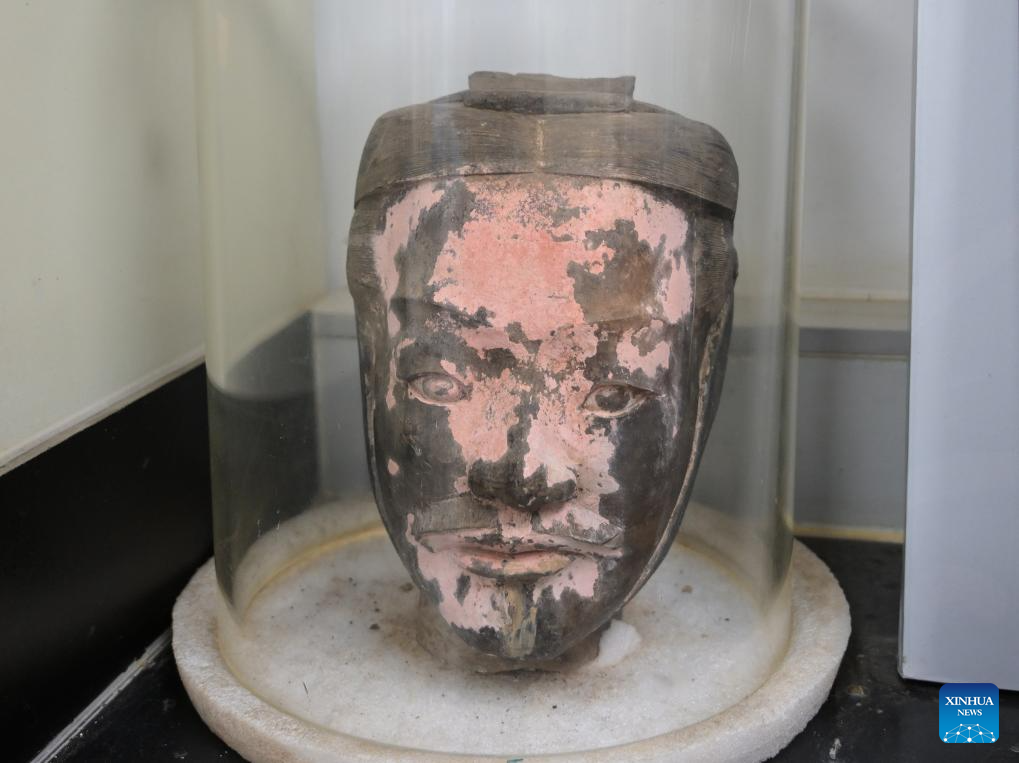
This photo taken on Aug. 23, 2023 shows a piece of the painted Terracotta Warriors at the Emperor Qinshihuang's Mausoleum Site Museum in Xi'an, northwest China's Shaanxi Province.
"We are the Terracotta Warriors specialists, and this room is a 'hospital' for the relics in the museum," said Lan Desheng, an expert in the restoration of cultural relics with the Emperor Qinshihuang's Mausoleum Site Museum.
Archaeological research shows that pigments have been found on the Terracotta Warriors. The painted layers of the Terracotta Warriors are very fragile. Once unearthed, with the changes of humidity and temperature, the surface quickly dehydrates and the painted layer comes off. In addition, microorganisms, soluble salts and other factors also cause the color fading.
According to Lan, shortly after unearthing, each painted Terracotta Warrior must go through X-ray detection, ultrasonic scanning, 3D images acquisition and other procedures. Staff members clean and restore the pieces of the painted Terracotta Warriors using slim bamboo slips, scalpels, small brushes, etc. Every Terracotta Warrior also has its own ID. In recent years, Lan and his team have completed the restoration of more than 140 Terracotta Warriors.
Discovered in 1974 and listed as a world heritage site by UNESCO in 1987, the army of Terracotta Warriors was built by Emperor Qinshihuang of the Qin Dynasty (221 B.C.-207 B.C.). (Xinhua/Li He)
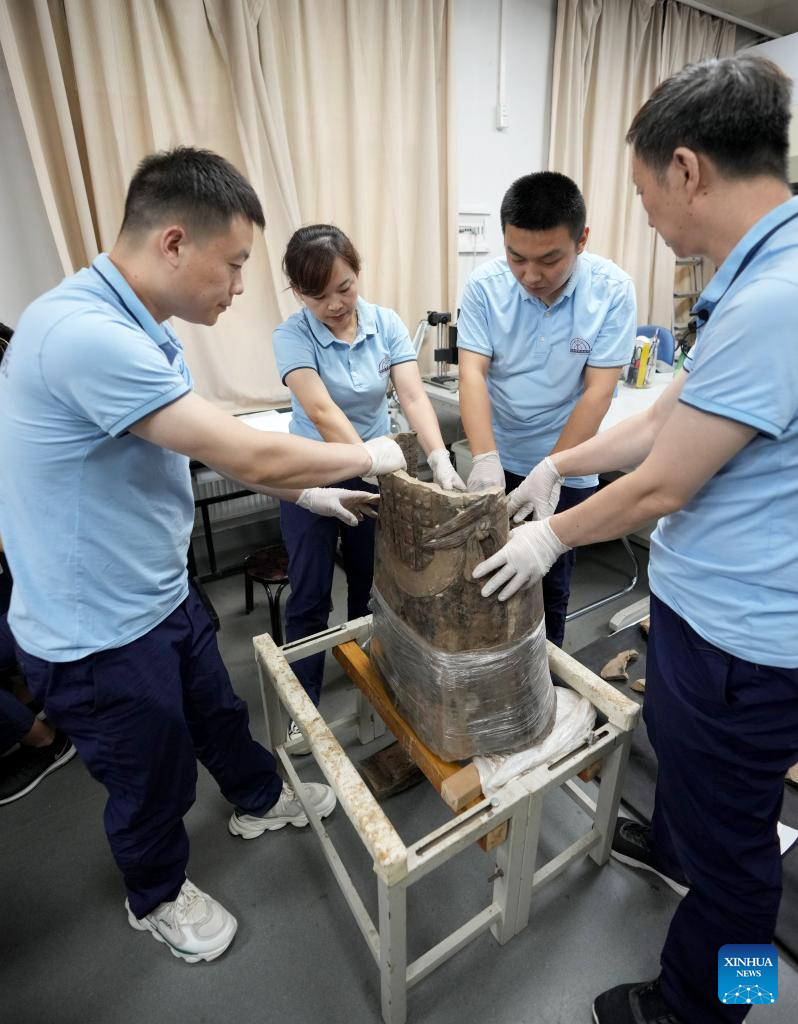
Technicians put pieces of a Terracotta Warrior together at the Emperor Qinshihuang's Mausoleum Site Museum in Xi'an, northwest China's Shaanxi Province, Aug. 23, 2023.
"We are the Terracotta Warriors specialists, and this room is a 'hospital' for the relics in the museum," said Lan Desheng, an expert in the restoration of cultural relics with the Emperor Qinshihuang's Mausoleum Site Museum.
Archaeological research shows that pigments have been found on the Terracotta Warriors. The painted layers of the Terracotta Warriors are very fragile. Once unearthed, with the changes of humidity and temperature, the surface quickly dehydrates and the painted layer comes off. In addition, microorganisms, soluble salts and other factors also cause the color fading.
According to Lan, shortly after unearthing, each painted Terracotta Warrior must go through X-ray detection, ultrasonic scanning, 3D images acquisition and other procedures. Staff members clean and restore the pieces of the painted Terracotta Warriors using slim bamboo slips, scalpels, small brushes, etc. Every Terracotta Warrior also has its own ID. In recent years, Lan and his team have completed the restoration of more than 140 Terracotta Warriors.
Discovered in 1974 and listed as a world heritage site by UNESCO in 1987, the army of Terracotta Warriors was built by Emperor Qinshihuang of the Qin Dynasty (221 B.C.-207 B.C.). (Xinhua/Wang Yuguo)
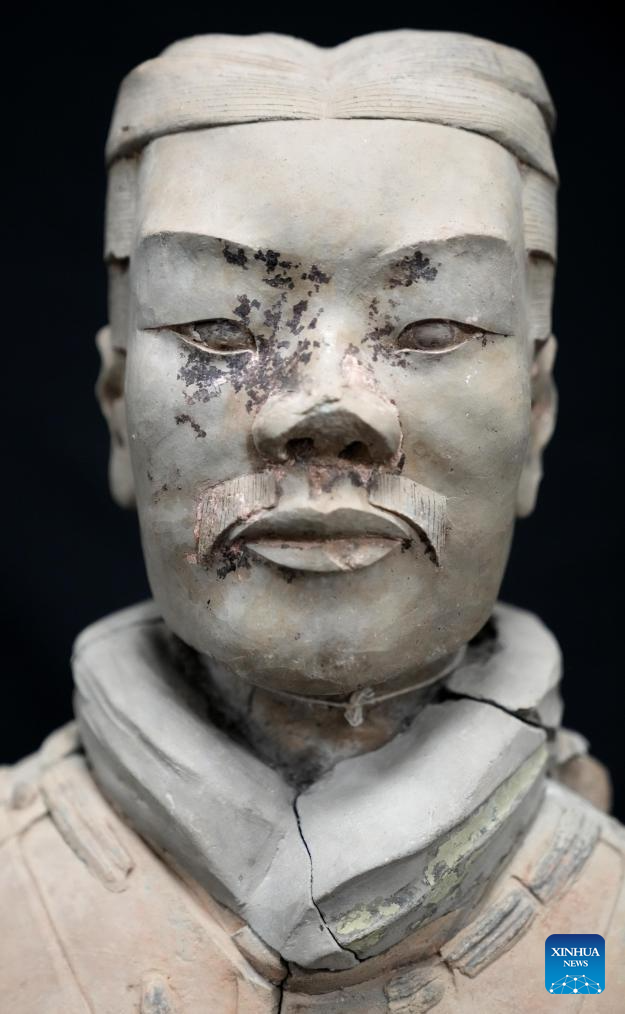
This photo taken on Aug. 23, 2023 shows a restored piece of the painted Terracotta Warriors at the Emperor Qinshihuang's Mausoleum Site Museum in Xi'an, northwest China's Shaanxi Province.
"We are the Terracotta Warriors specialists, and this room is a 'hospital' for the relics in the museum," said Lan Desheng, an expert in the restoration of cultural relics with the Emperor Qinshihuang's Mausoleum Site Museum.
Archaeological research shows that pigments have been found on the Terracotta Warriors. The painted layers of the Terracotta Warriors are very fragile. Once unearthed, with the changes of humidity and temperature, the surface quickly dehydrates and the painted layer comes off. In addition, microorganisms, soluble salts and other factors also cause the color fading.
According to Lan, shortly after unearthing, each painted Terracotta Warrior must go through X-ray detection, ultrasonic scanning, 3D images acquisition and other procedures. Staff members clean and restore the pieces of the painted Terracotta Warriors using slim bamboo slips, scalpels, small brushes, etc. Every Terracotta Warrior also has its own ID. In recent years, Lan and his team have completed the restoration of more than 140 Terracotta Warriors.
Discovered in 1974 and listed as a world heritage site by UNESCO in 1987, the army of Terracotta Warriors was built by Emperor Qinshihuang of the Qin Dynasty (221 B.C.-207 B.C.). (Xinhua/Wang Yuguo)
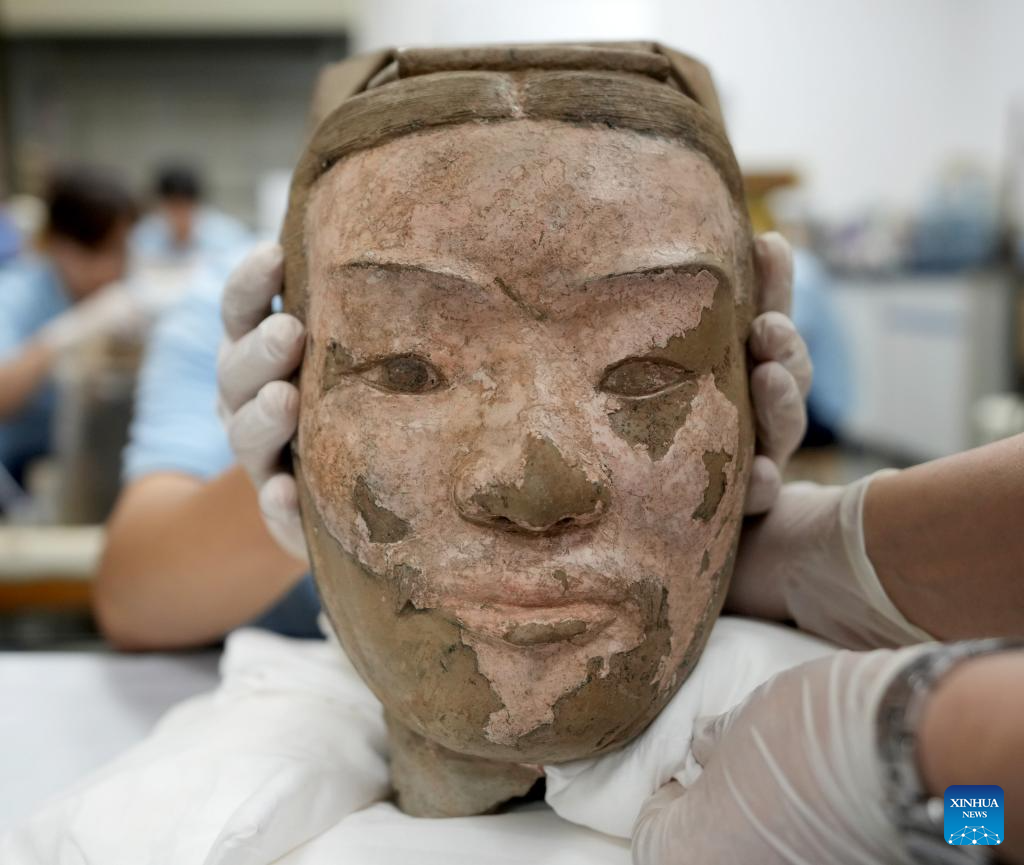
This photo taken on Aug. 23, 2023 shows a restored piece of the painted Terracotta Warriors at the Emperor Qinshihuang's Mausoleum Site Museum in Xi'an, northwest China's Shaanxi Province.
"We are the Terracotta Warriors specialists, and this room is a 'hospital' for the relics in the museum," said Lan Desheng, an expert in the restoration of cultural relics with the Emperor Qinshihuang's Mausoleum Site Museum.
Archaeological research shows that pigments have been found on the Terracotta Warriors. The painted layers of the Terracotta Warriors are very fragile. Once unearthed, with the changes of humidity and temperature, the surface quickly dehydrates and the painted layer comes off. In addition, microorganisms, soluble salts and other factors also cause the color fading.
According to Lan, shortly after unearthing, each painted Terracotta Warrior must go through X-ray detection, ultrasonic scanning, 3D images acquisition and other procedures. Staff members clean and restore the pieces of the painted Terracotta Warriors using slim bamboo slips, scalpels, small brushes, etc. Every Terracotta Warrior also has its own ID. In recent years, Lan and his team have completed the restoration of more than 140 Terracotta Warriors.
Discovered in 1974 and listed as a world heritage site by UNESCO in 1987, the army of Terracotta Warriors was built by Emperor Qinshihuang of the Qin Dynasty (221 B.C.-207 B.C.). (Xinhua/Wang Yuguo)
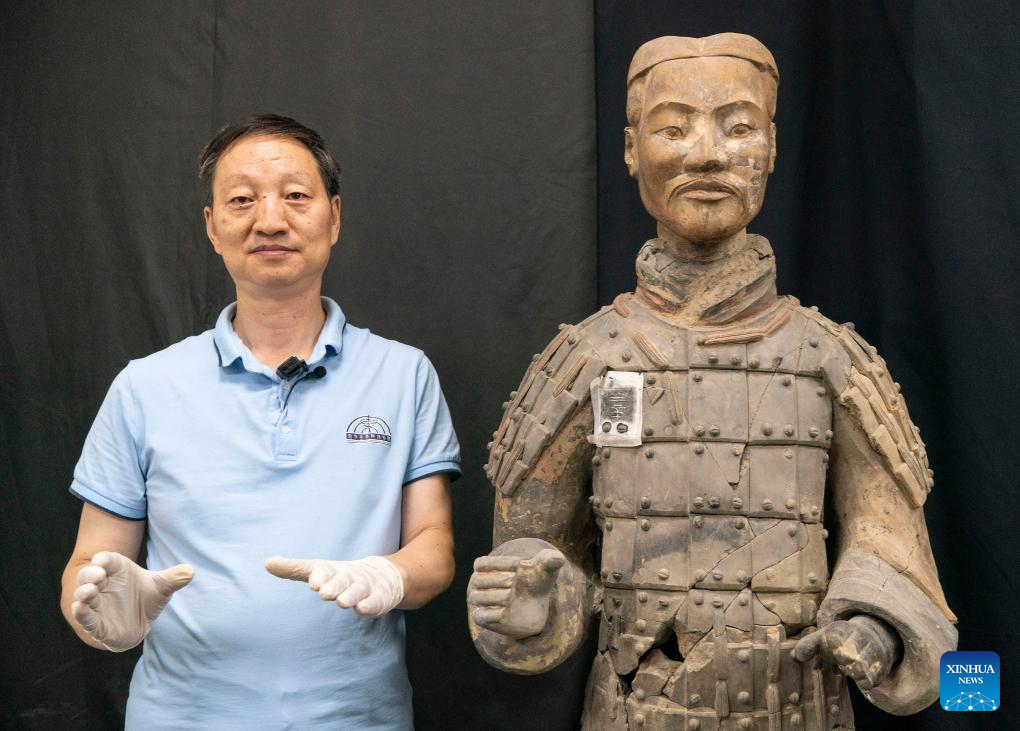
Lan Desheng gestures as a restored painted Terracotta Warrior at the Emperor Qinshihuang's Mausoleum Site Museum in Xi'an, northwest China's Shaanxi Province, Aug. 23, 2023.
"We are the Terracotta Warriors specialists, and this room is a 'hospital' for the relics in the museum," said Lan Desheng, an expert in the restoration of cultural relics with the Emperor Qinshihuang's Mausoleum Site Museum.
Archaeological research shows that pigments have been found on the Terracotta Warriors. The painted layers of the Terracotta Warriors are very fragile. Once unearthed, with the changes of humidity and temperature, the surface quickly dehydrates and the painted layer comes off. In addition, microorganisms, soluble salts and other factors also cause the color fading.
According to Lan, shortly after unearthing, each painted Terracotta Warrior must go through X-ray detection, ultrasonic scanning, 3D images acquisition and other procedures. Staff members clean and restore the pieces of the painted Terracotta Warriors using slim bamboo slips, scalpels, small brushes, etc. Every Terracotta Warrior also has its own ID. In recent years, Lan and his team have completed the restoration of more than 140 Terracotta Warriors.
Discovered in 1974 and listed as a world heritage site by UNESCO in 1987, the army of Terracotta Warriors was built by Emperor Qinshihuang of the Qin Dynasty (221 B.C.-207 B.C.). (Xinhua/Cai Yang)
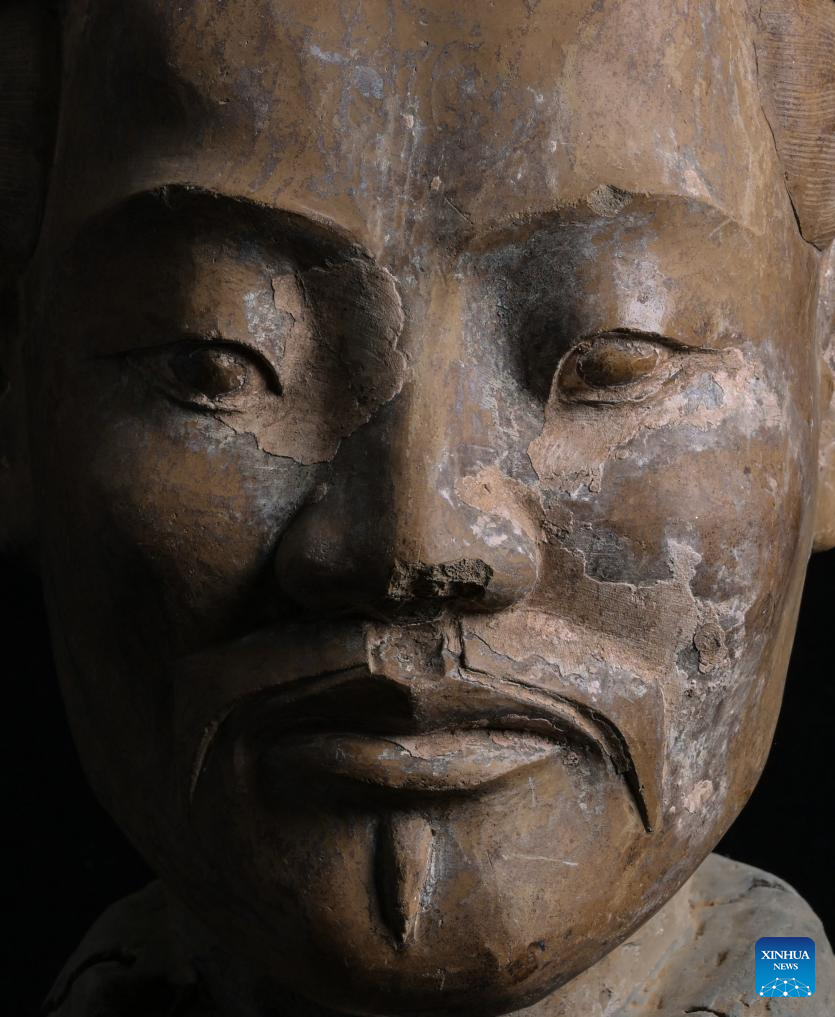
This photo taken on Aug. 23, 2023 shows a piece of the painted Terracotta Warriors at the Emperor Qinshihuang's Mausoleum Site Museum in Xi'an, northwest China's Shaanxi Province.
"We are the Terracotta Warriors specialists, and this room is a 'hospital' for the relics in the museum," said Lan Desheng, an expert in the restoration of cultural relics with the Emperor Qinshihuang's Mausoleum Site Museum.
Archaeological research shows that pigments have been found on the Terracotta Warriors. The painted layers of the Terracotta Warriors are very fragile. Once unearthed, with the changes of humidity and temperature, the surface quickly dehydrates and the painted layer comes off. In addition, microorganisms, soluble salts and other factors also cause the color fading.
According to Lan, shortly after unearthing, each painted Terracotta Warrior must go through X-ray detection, ultrasonic scanning, 3D images acquisition and other procedures. Staff members clean and restore the pieces of the painted Terracotta Warriors using slim bamboo slips, scalpels, small brushes, etc. Every Terracotta Warrior also has its own ID. In recent years, Lan and his team have completed the restoration of more than 140 Terracotta Warriors.
Discovered in 1974 and listed as a world heritage site by UNESCO in 1987, the army of Terracotta Warriors was built by Emperor Qinshihuang of the Qin Dynasty (221 B.C.-207 B.C.). (Xinhua/Li He)
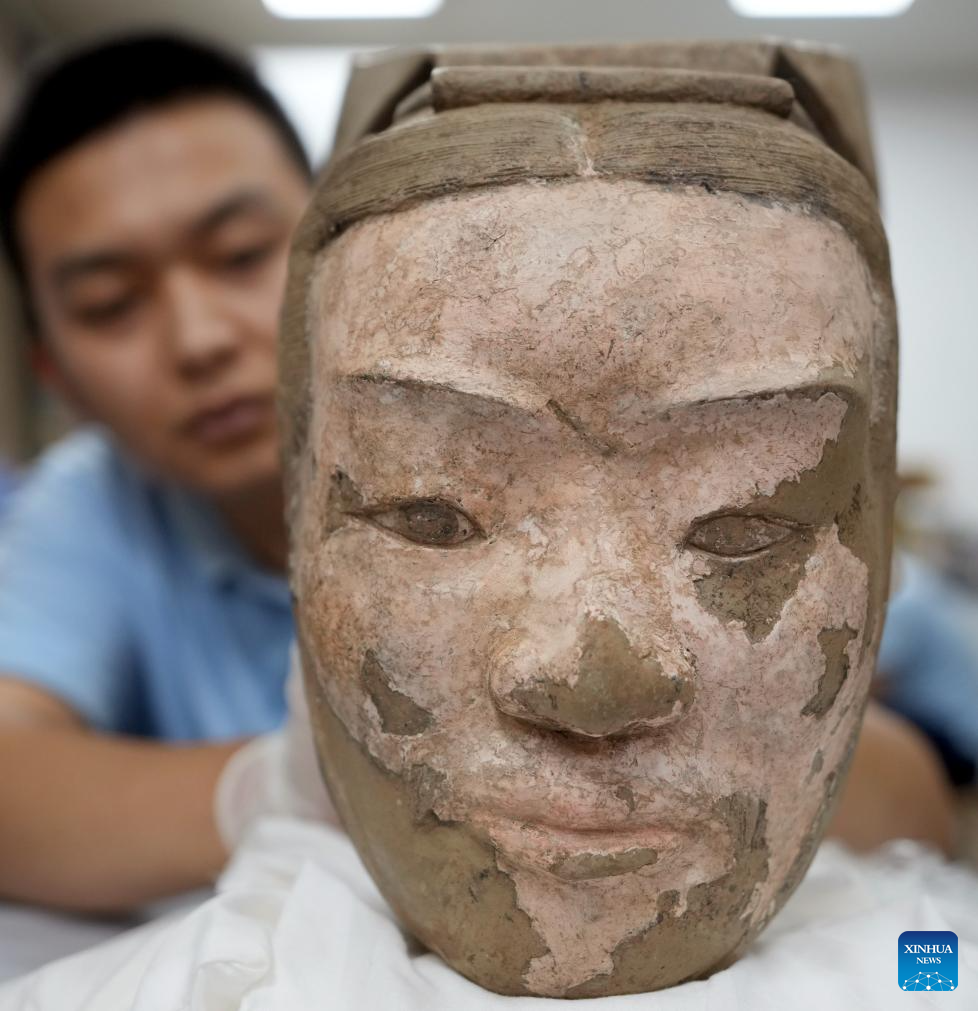
This photo taken on Aug. 23, 2023 shows a restored piece of the painted Terracotta Warriors at the Emperor Qinshihuang's Mausoleum Site Museum in Xi'an, northwest China's Shaanxi Province.
"We are the Terracotta Warriors specialists, and this room is a 'hospital' for the relics in the museum," said Lan Desheng, an expert in the restoration of cultural relics with the Emperor Qinshihuang's Mausoleum Site Museum.
Archaeological research shows that pigments have been found on the Terracotta Warriors. The painted layers of the Terracotta Warriors are very fragile. Once unearthed, with the changes of humidity and temperature, the surface quickly dehydrates and the painted layer comes off. In addition, microorganisms, soluble salts and other factors also cause the color fading.
According to Lan, shortly after unearthing, each painted Terracotta Warrior must go through X-ray detection, ultrasonic scanning, 3D images acquisition and other procedures. Staff members clean and restore the pieces of the painted Terracotta Warriors using slim bamboo slips, scalpels, small brushes, etc. Every Terracotta Warrior also has its own ID. In recent years, Lan and his team have completed the restoration of more than 140 Terracotta Warriors.
Discovered in 1974 and listed as a world heritage site by UNESCO in 1987, the army of Terracotta Warriors was built by Emperor Qinshihuang of the Qin Dynasty (221 B.C.-207 B.C.). (Xinhua/Wang Yuguo)
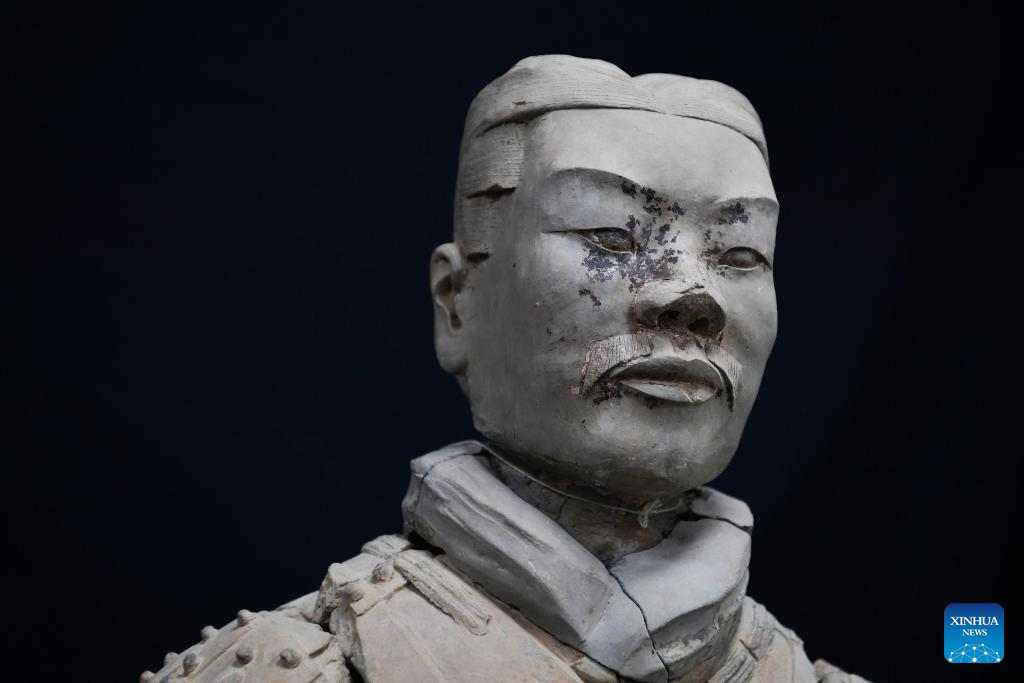
This photo taken on Aug. 23, 2023 shows a piece of the painted Terracotta Warriors at the Emperor Qinshihuang's Mausoleum Site Museum in Xi'an, northwest China's Shaanxi Province.
"We are the Terracotta Warriors specialists, and this room is a 'hospital' for the relics in the museum," said Lan Desheng, an expert in the restoration of cultural relics with the Emperor Qinshihuang's Mausoleum Site Museum.
Archaeological research shows that pigments have been found on the Terracotta Warriors. The painted layers of the Terracotta Warriors are very fragile. Once unearthed, with the changes of humidity and temperature, the surface quickly dehydrates and the painted layer comes off. In addition, microorganisms, soluble salts and other factors also cause the color fading.
According to Lan, shortly after unearthing, each painted Terracotta Warrior must go through X-ray detection, ultrasonic scanning, 3D images acquisition and other procedures. Staff members clean and restore the pieces of the painted Terracotta Warriors using slim bamboo slips, scalpels, small brushes, etc. Every Terracotta Warrior also has its own ID. In recent years, Lan and his team have completed the restoration of more than 140 Terracotta Warriors.
Discovered in 1974 and listed as a world heritage site by UNESCO in 1987, the army of Terracotta Warriors was built by Emperor Qinshihuang of the Qin Dynasty (221 B.C.-207 B.C.). (Xinhua/Zhang Bowen)
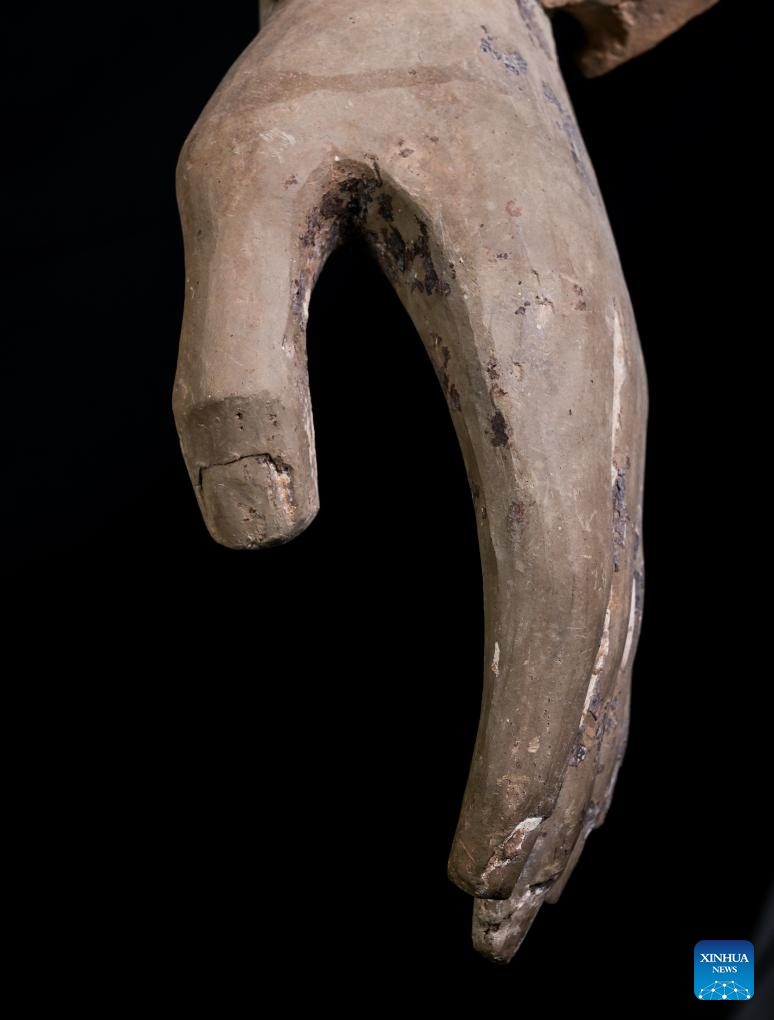
This photo taken on Aug. 23, 2023 shows a piece of the painted Terracotta Warriors at the Emperor Qinshihuang's Mausoleum Site Museum in Xi'an, northwest China's Shaanxi Province.
"We are the Terracotta Warriors specialists, and this room is a 'hospital' for the relics in the museum," said Lan Desheng, an expert in the restoration of cultural relics with the Emperor Qinshihuang's Mausoleum Site Museum.
Archaeological research shows that pigments have been found on the Terracotta Warriors. The painted layers of the Terracotta Warriors are very fragile. Once unearthed, with the changes of humidity and temperature, the surface quickly dehydrates and the painted layer comes off. In addition, microorganisms, soluble salts and other factors also cause the color fading.
According to Lan, shortly after unearthing, each painted Terracotta Warrior must go through X-ray detection, ultrasonic scanning, 3D images acquisition and other procedures. Staff members clean and restore the pieces of the painted Terracotta Warriors using slim bamboo slips, scalpels, small brushes, etc. Every Terracotta Warrior also has its own ID. In recent years, Lan and his team have completed the restoration of more than 140 Terracotta Warriors.
Discovered in 1974 and listed as a world heritage site by UNESCO in 1987, the army of Terracotta Warriors was built by Emperor Qinshihuang of the Qin Dynasty (221 B.C.-207 B.C.). (Xinhua/Li He)
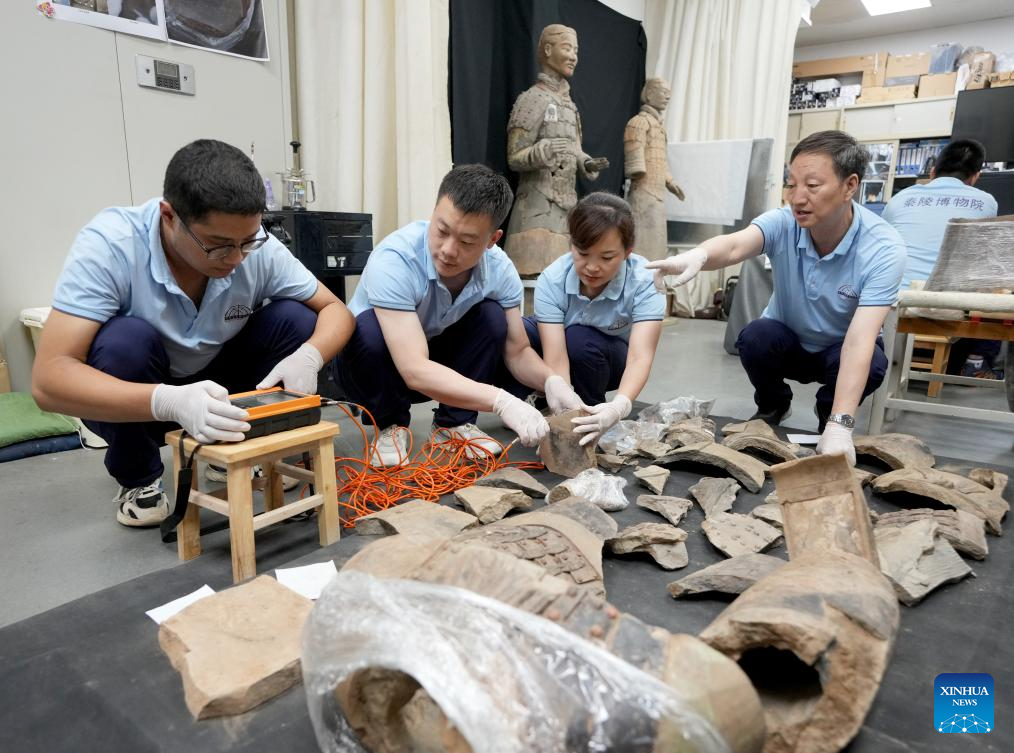
Lan Desheng (1st, R) guides technicians to measure the density of the painted Terracotta Warriors with an ultrasonic device at the Emperor Qinshihuang's Mausoleum Site Museum in Xi'an, northwest China's Shaanxi Province, Aug. 23, 2023.
"We are the Terracotta Warriors specialists, and this room is a 'hospital' for the relics in the museum," said Lan Desheng, an expert in the restoration of cultural relics with the Emperor Qinshihuang's Mausoleum Site Museum.
Archaeological research shows that pigments have been found on the Terracotta Warriors. The painted layers of the Terracotta Warriors are very fragile. Once unearthed, with the changes of humidity and temperature, the surface quickly dehydrates and the painted layer comes off. In addition, microorganisms, soluble salts and other factors also cause the color fading.
According to Lan, shortly after unearthing, each painted Terracotta Warrior must go through X-ray detection, ultrasonic scanning, 3D images acquisition and other procedures. Staff members clean and restore the pieces of the painted Terracotta Warriors using slim bamboo slips, scalpels, small brushes, etc. Every Terracotta Warrior also has its own ID. In recent years, Lan and his team have completed the restoration of more than 140 Terracotta Warriors.
Discovered in 1974 and listed as a world heritage site by UNESCO in 1987, the army of Terracotta Warriors was built by Emperor Qinshihuang of the Qin Dynasty (221 B.C.-207 B.C.). (Xinhua/Wang Yuguo)
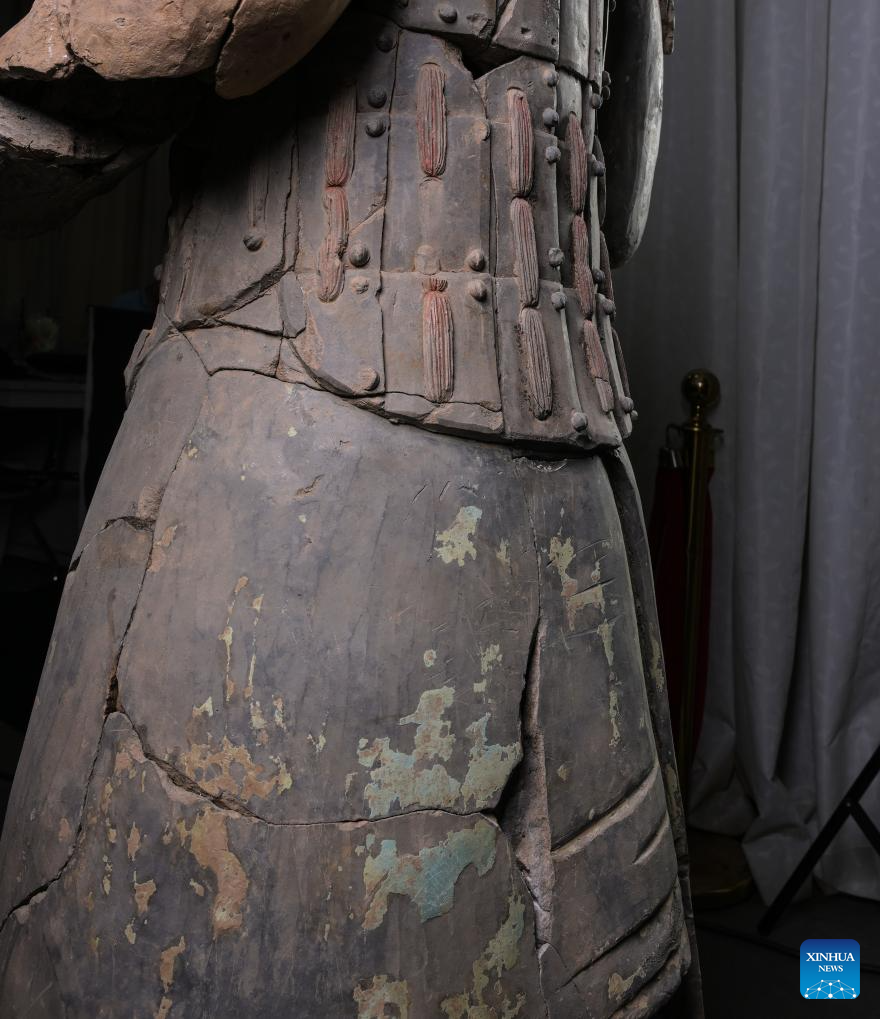
This photo taken on Aug. 23, 2023 shows a piece of the painted Terracotta Warriors at the Emperor Qinshihuang's Mausoleum Site Museum in Xi'an, northwest China's Shaanxi Province.
"We are the Terracotta Warriors specialists, and this room is a 'hospital' for the relics in the museum," said Lan Desheng, an expert in the restoration of cultural relics with the Emperor Qinshihuang's Mausoleum Site Museum.
Archaeological research shows that pigments have been found on the Terracotta Warriors. The painted layers of the Terracotta Warriors are very fragile. Once unearthed, with the changes of humidity and temperature, the surface quickly dehydrates and the painted layer comes off. In addition, microorganisms, soluble salts and other factors also cause the color fading.
According to Lan, shortly after unearthing, each painted Terracotta Warrior must go through X-ray detection, ultrasonic scanning, 3D images acquisition and other procedures. Staff members clean and restore the pieces of the painted Terracotta Warriors using slim bamboo slips, scalpels, small brushes, etc. Every Terracotta Warrior also has its own ID. In recent years, Lan and his team have completed the restoration of more than 140 Terracotta Warriors.
Discovered in 1974 and listed as a world heritage site by UNESCO in 1987, the army of Terracotta Warriors was built by Emperor Qinshihuang of the Qin Dynasty (221 B.C.-207 B.C.). (Xinhua/Li He)
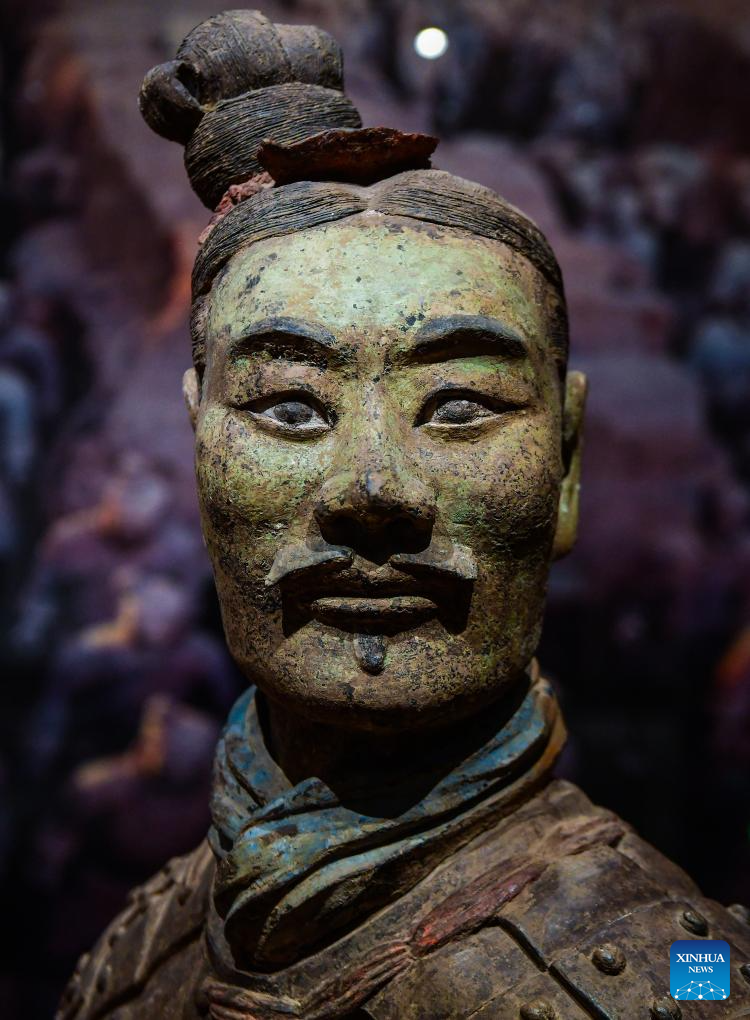
This photo taken on May 18, 2021 shows a painted Terracotta Warrior displayed at the Capital Museum in Beijing, capital of China.
"We are the Terracotta Warriors specialists, and this room is a 'hospital' for the relics in the museum," said Lan Desheng, an expert in the restoration of cultural relics with the Emperor Qinshihuang's Mausoleum Site Museum.
Archaeological research shows that pigments have been found on the Terracotta Warriors. The painted layers of the Terracotta Warriors are very fragile. Once unearthed, with the changes of humidity and temperature, the surface quickly dehydrates and the painted layer comes off. In addition, microorganisms, soluble salts and other factors also cause the color fading.
According to Lan, shortly after unearthing, each painted Terracotta Warrior must go through X-ray detection, ultrasonic scanning, 3D images acquisition and other procedures. Staff members clean and restore the pieces of the painted Terracotta Warriors using slim bamboo slips, scalpels, small brushes, etc. Every Terracotta Warrior also has its own ID. In recent years, Lan and his team have completed the restoration of more than 140 Terracotta Warriors.
Discovered in 1974 and listed as a world heritage site by UNESCO in 1987, the army of Terracotta Warriors was built by Emperor Qinshihuang of the Qin Dynasty (221 B.C.-207 B.C.). (Xinhua/Li He)
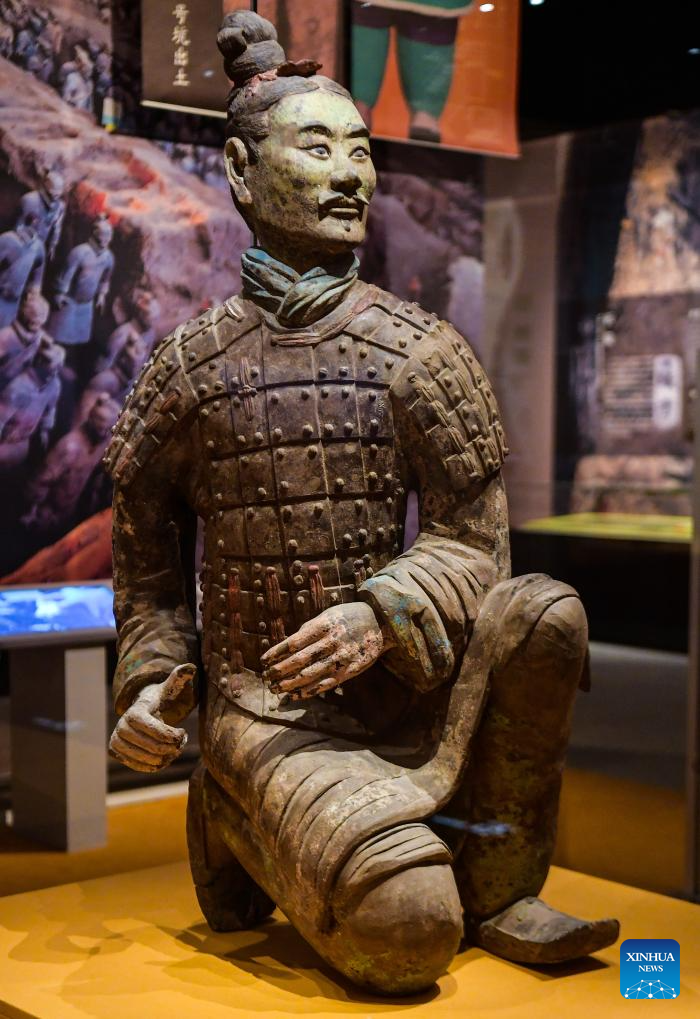
This photo taken on May 18, 2021 shows a painted Terracotta Warrior displayed at the Capital Museum in Beijing, capital of China.
"We are the Terracotta Warriors specialists, and this room is a 'hospital' for the relics in the museum," said Lan Desheng, an expert in the restoration of cultural relics with the Emperor Qinshihuang's Mausoleum Site Museum.
Archaeological research shows that pigments have been found on the Terracotta Warriors. The painted layers of the Terracotta Warriors are very fragile. Once unearthed, with the changes of humidity and temperature, the surface quickly dehydrates and the painted layer comes off. In addition, microorganisms, soluble salts and other factors also cause the color fading.
According to Lan, shortly after unearthing, each painted Terracotta Warrior must go through X-ray detection, ultrasonic scanning, 3D images acquisition and other procedures. Staff members clean and restore the pieces of the painted Terracotta Warriors using slim bamboo slips, scalpels, small brushes, etc. Every Terracotta Warrior also has its own ID. In recent years, Lan and his team have completed the restoration of more than 140 Terracotta Warriors.
Discovered in 1974 and listed as a world heritage site by UNESCO in 1987, the army of Terracotta Warriors was built by Emperor Qinshihuang of the Qin Dynasty (221 B.C.-207 B.C.). (Xinhua/Li He)
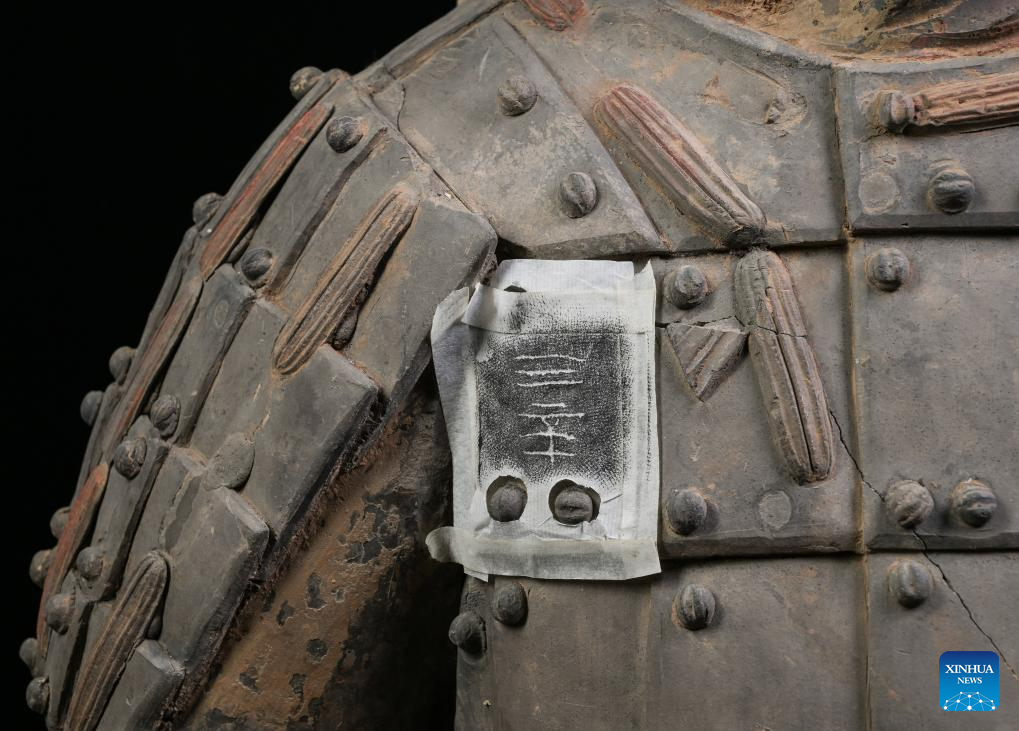
This photo taken on Aug. 23, 2023 shows a restored piece of the painted Terracotta Warriors at the Emperor Qinshihuang's Mausoleum Site Museum in Xi'an, northwest China's Shaanxi Province. The writings on the statue indicate the name of the craftsman who made it.
"We are the Terracotta Warriors specialists, and this room is a 'hospital' for the relics in the museum," said Lan Desheng, an expert in the restoration of cultural relics with the Emperor Qinshihuang's Mausoleum Site Museum.
Archaeological research shows that pigments have been found on the Terracotta Warriors. The painted layers of the Terracotta Warriors are very fragile. Once unearthed, with the changes of humidity and temperature, the surface quickly dehydrates and the painted layer comes off. In addition, microorganisms, soluble salts and other factors also cause the color fading.
According to Lan, shortly after unearthing, each painted Terracotta Warrior must go through X-ray detection, ultrasonic scanning, 3D images acquisition and other procedures. Staff members clean and restore the pieces of the painted Terracotta Warriors using slim bamboo slips, scalpels, small brushes, etc. Every Terracotta Warrior also has its own ID. In recent years, Lan and his team have completed the restoration of more than 140 Terracotta Warriors.
Discovered in 1974 and listed as a world heritage site by UNESCO in 1987, the army of Terracotta Warriors was built by Emperor Qinshihuang of the Qin Dynasty (221 B.C.-207 B.C.). (Xinhua/Li He)
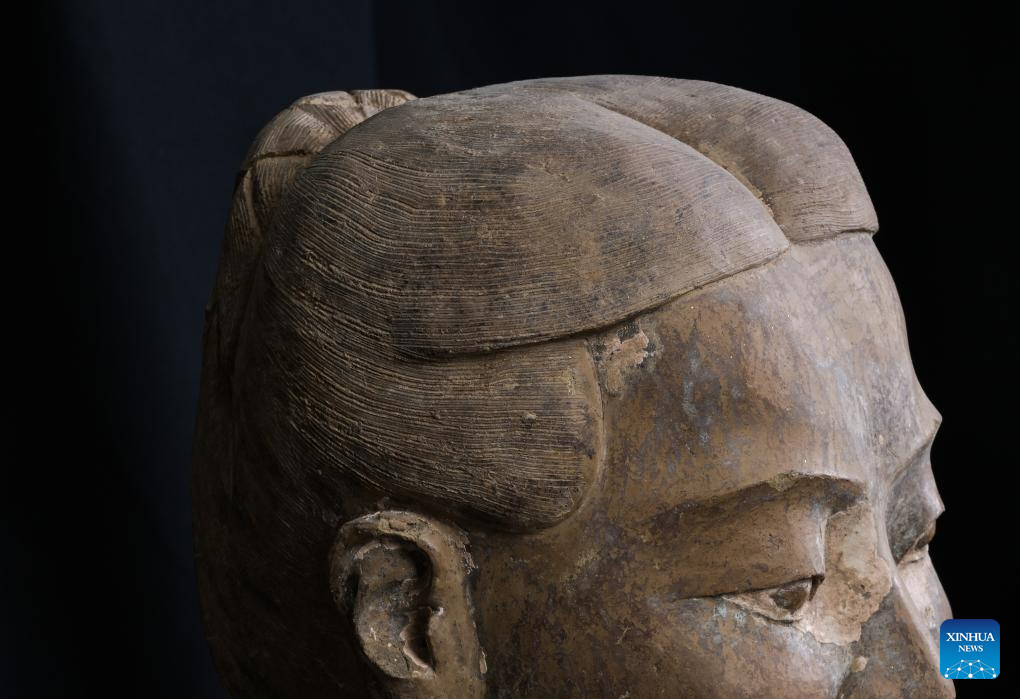
This photo taken on Aug. 23, 2023 shows a piece of the painted Terracotta Warriors at the Emperor Qinshihuang's Mausoleum Site Museum in Xi'an, northwest China's Shaanxi Province.
"We are the Terracotta Warriors specialists, and this room is a 'hospital' for the relics in the museum," said Lan Desheng, an expert in the restoration of cultural relics with the Emperor Qinshihuang's Mausoleum Site Museum.
Archaeological research shows that pigments have been found on the Terracotta Warriors. The painted layers of the Terracotta Warriors are very fragile. Once unearthed, with the changes of humidity and temperature, the surface quickly dehydrates and the painted layer comes off. In addition, microorganisms, soluble salts and other factors also cause the color fading.
According to Lan, shortly after unearthing, each painted Terracotta Warrior must go through X-ray detection, ultrasonic scanning, 3D images acquisition and other procedures. Staff members clean and restore the pieces of the painted Terracotta Warriors using slim bamboo slips, scalpels, small brushes, etc. Every Terracotta Warrior also has its own ID. In recent years, Lan and his team have completed the restoration of more than 140 Terracotta Warriors.
Discovered in 1974 and listed as a world heritage site by UNESCO in 1987, the army of Terracotta Warriors was built by Emperor Qinshihuang of the Qin Dynasty (221 B.C.-207 B.C.). (Xinhua/Li He)
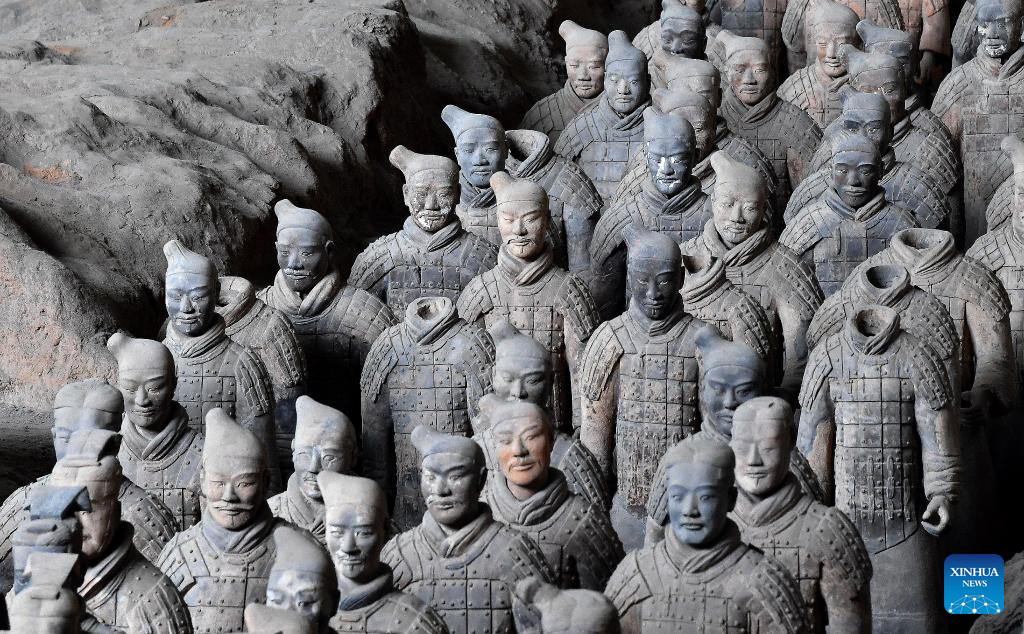
This photo taken on April 26, 2023 shows the Terracotta Warriors at the pit No.1 of the Emperor Qinshihuang's Mausoleum Site Museum in Xi'an, northwest China's Shaanxi Province.
"We are the Terracotta Warriors specialists, and this room is a 'hospital' for the relics in the museum," said Lan Desheng, an expert in the restoration of cultural relics with the Emperor Qinshihuang's Mausoleum Site Museum.
Archaeological research shows that pigments have been found on the Terracotta Warriors. The painted layers of the Terracotta Warriors are very fragile. Once unearthed, with the changes of humidity and temperature, the surface quickly dehydrates and the painted layer comes off. In addition, microorganisms, soluble salts and other factors also cause the color fading.
According to Lan, shortly after unearthing, each painted Terracotta Warrior must go through X-ray detection, ultrasonic scanning, 3D images acquisition and other procedures. Staff members clean and restore the pieces of the painted Terracotta Warriors using slim bamboo slips, scalpels, small brushes, etc. Every Terracotta Warrior also has its own ID. In recent years, Lan and his team have completed the restoration of more than 140 Terracotta Warriors.
Discovered in 1974 and listed as a world heritage site by UNESCO in 1987, the army of Terracotta Warriors was built by Emperor Qinshihuang of the Qin Dynasty (221 B.C.-207 B.C.). (Xinhua/Liu Xiao)
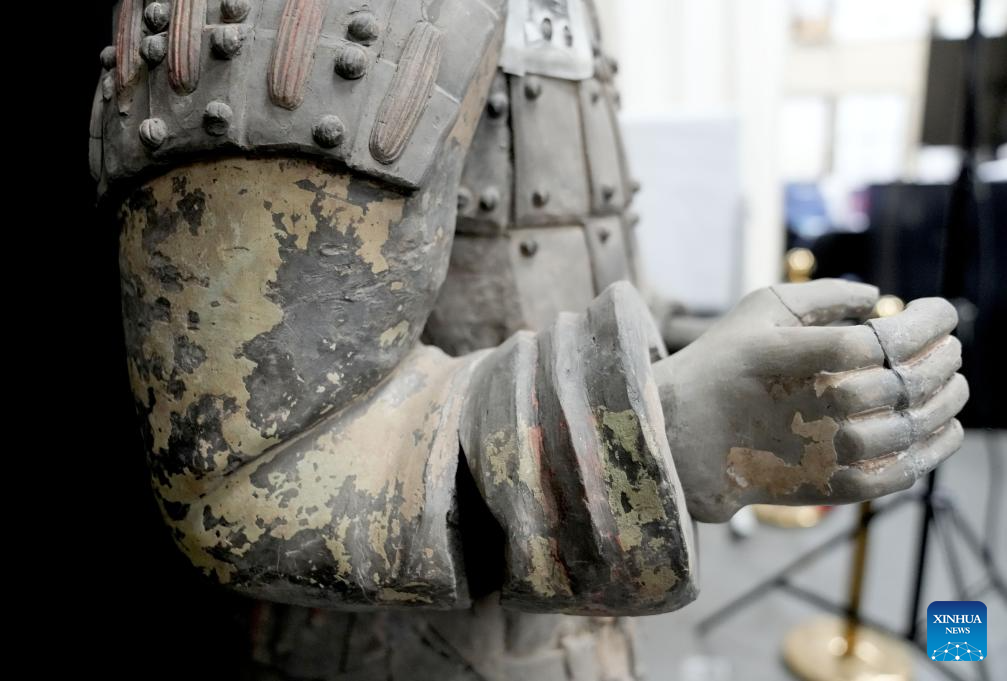
This photo taken on Aug. 23, 2023 shows a restored piece of the painted Terracotta Warriors at the Emperor Qinshihuang's Mausoleum Site Museum in Xi'an, northwest China's Shaanxi Province.
"We are the Terracotta Warriors specialists, and this room is a 'hospital' for the relics in the museum," said Lan Desheng, an expert in the restoration of cultural relics with the Emperor Qinshihuang's Mausoleum Site Museum.
Archaeological research shows that pigments have been found on the Terracotta Warriors. The painted layers of the Terracotta Warriors are very fragile. Once unearthed, with the changes of humidity and temperature, the surface quickly dehydrates and the painted layer comes off. In addition, microorganisms, soluble salts and other factors also cause the color fading.
According to Lan, shortly after unearthing, each painted Terracotta Warrior must go through X-ray detection, ultrasonic scanning, 3D images acquisition and other procedures. Staff members clean and restore the pieces of the painted Terracotta Warriors using slim bamboo slips, scalpels, small brushes, etc. Every Terracotta Warrior also has its own ID. In recent years, Lan and his team have completed the restoration of more than 140 Terracotta Warriors.
Discovered in 1974 and listed as a world heritage site by UNESCO in 1987, the army of Terracotta Warriors was built by Emperor Qinshihuang of the Qin Dynasty (221 B.C.-207 B.C.). (Xinhua/Wang Yuguo)

This photo taken on Aug. 23, 2023 shows a restored piece of the painted Terracotta Warriors at the Emperor Qinshihuang's Mausoleum Site Museum in Xi'an, northwest China's Shaanxi Province.
"We are the Terracotta Warriors specialists, and this room is a 'hospital' for the relics in the museum," said Lan Desheng, an expert in the restoration of cultural relics with the Emperor Qinshihuang's Mausoleum Site Museum.
Archaeological research shows that pigments have been found on the Terracotta Warriors. The painted layers of the Terracotta Warriors are very fragile. Once unearthed, with the changes of humidity and temperature, the surface quickly dehydrates and the painted layer comes off. In addition, microorganisms, soluble salts and other factors also cause the color fading.
According to Lan, shortly after unearthing, each painted Terracotta Warrior must go through X-ray detection, ultrasonic scanning, 3D images acquisition and other procedures. Staff members clean and restore the pieces of the painted Terracotta Warriors using slim bamboo slips, scalpels, small brushes, etc. Every Terracotta Warrior also has its own ID. In recent years, Lan and his team have completed the restoration of more than 140 Terracotta Warriors.
Discovered in 1974 and listed as a world heritage site by UNESCO in 1987, the army of Terracotta Warriors was built by Emperor Qinshihuang of the Qin Dynasty (221 B.C.-207 B.C.). (Xinhua/Wang Yuguo)
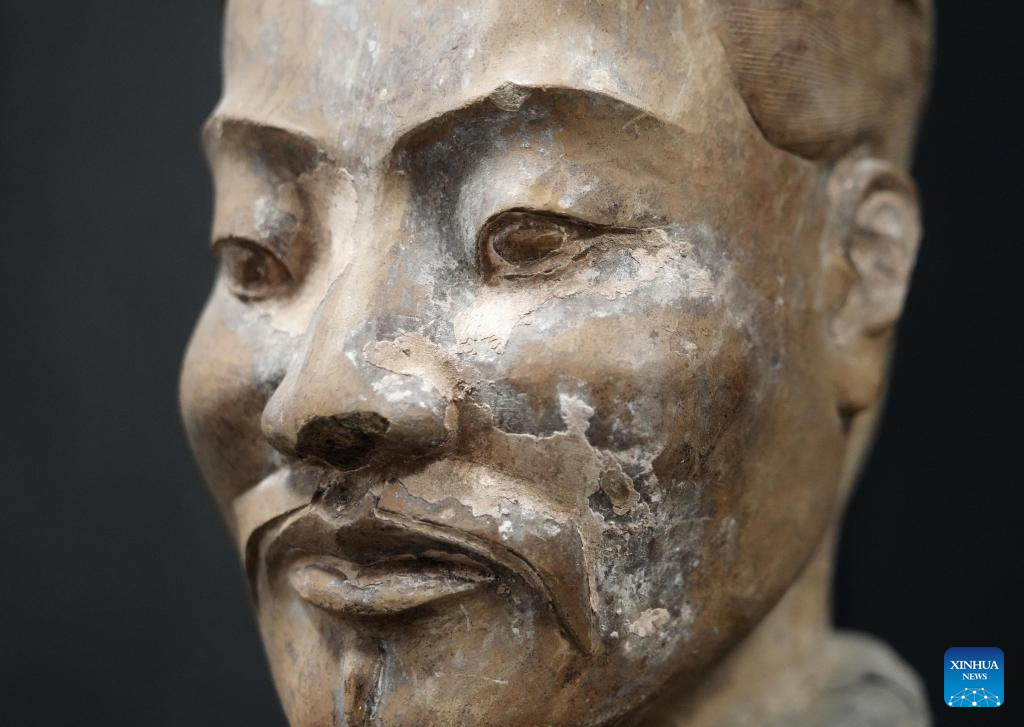
This photo taken on Aug. 23, 2023 shows a restored piece of the painted Terracotta Warriors at the Emperor Qinshihuang's Mausoleum Site Museum in Xi'an, northwest China's Shaanxi Province.
"We are the Terracotta Warriors specialists, and this room is a 'hospital' for the relics in the museum," said Lan Desheng, an expert in the restoration of cultural relics with the Emperor Qinshihuang's Mausoleum Site Museum.
Archaeological research shows that pigments have been found on the Terracotta Warriors. The painted layers of the Terracotta Warriors are very fragile. Once unearthed, with the changes of humidity and temperature, the surface quickly dehydrates and the painted layer comes off. In addition, microorganisms, soluble salts and other factors also cause the color fading.
According to Lan, shortly after unearthing, each painted Terracotta Warrior must go through X-ray detection, ultrasonic scanning, 3D images acquisition and other procedures. Staff members clean and restore the pieces of the painted Terracotta Warriors using slim bamboo slips, scalpels, small brushes, etc. Every Terracotta Warrior also has its own ID. In recent years, Lan and his team have completed the restoration of more than 140 Terracotta Warriors.
Discovered in 1974 and listed as a world heritage site by UNESCO in 1987, the army of Terracotta Warriors was built by Emperor Qinshihuang of the Qin Dynasty (221 B.C.-207 B.C.). (Xinhua/Wang Yuguo)
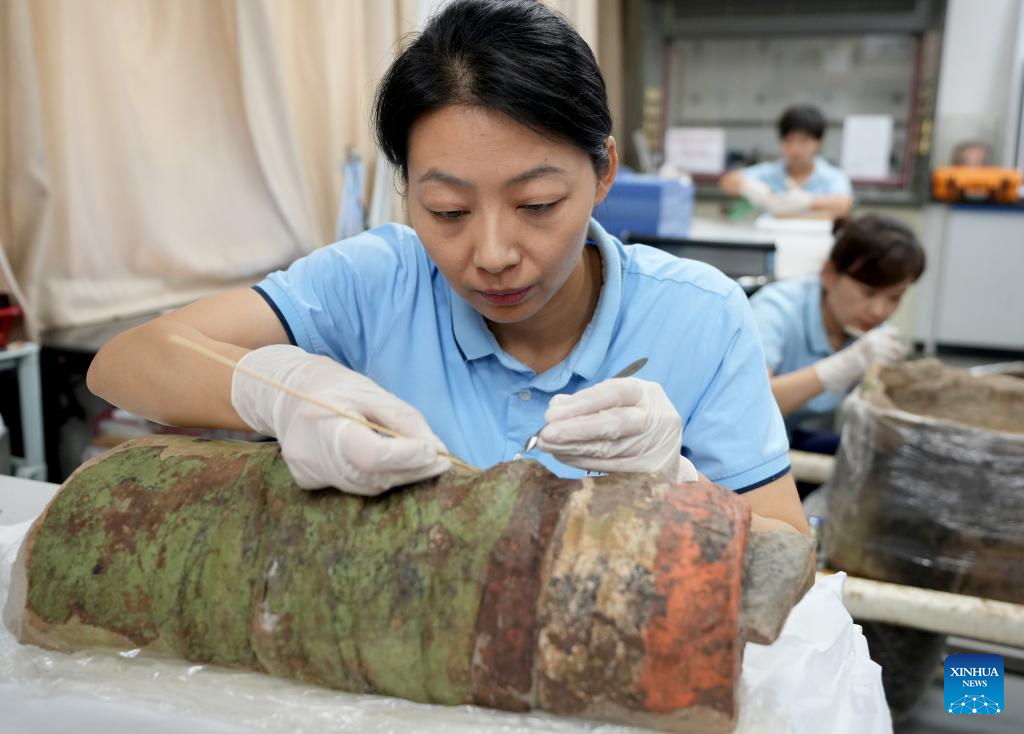
A technician restores the painted layer of a Terracotta Warrior at the Emperor Qinshihuang's Mausoleum Site Museum in Xi'an, northwest China's Shaanxi Province, Aug. 23, 2023.
"We are the Terracotta Warriors specialists, and this room is a 'hospital' for the relics in the museum," said Lan Desheng, an expert in the restoration of cultural relics with the Emperor Qinshihuang's Mausoleum Site Museum.
Archaeological research shows that pigments have been found on the Terracotta Warriors. The painted layers of the Terracotta Warriors are very fragile. Once unearthed, with the changes of humidity and temperature, the surface quickly dehydrates and the painted layer comes off. In addition, microorganisms, soluble salts and other factors also cause the color fading.
According to Lan, shortly after unearthing, each painted Terracotta Warrior must go through X-ray detection, ultrasonic scanning, 3D images acquisition and other procedures. Staff members clean and restore the pieces of the painted Terracotta Warriors using slim bamboo slips, scalpels, small brushes, etc. Every Terracotta Warrior also has its own ID. In recent years, Lan and his team have completed the restoration of more than 140 Terracotta Warriors.
Discovered in 1974 and listed as a world heritage site by UNESCO in 1987, the army of Terracotta Warriors was built by Emperor Qinshihuang of the Qin Dynasty (221 B.C.-207 B.C.). (Xinhua/Wang Yuguo)
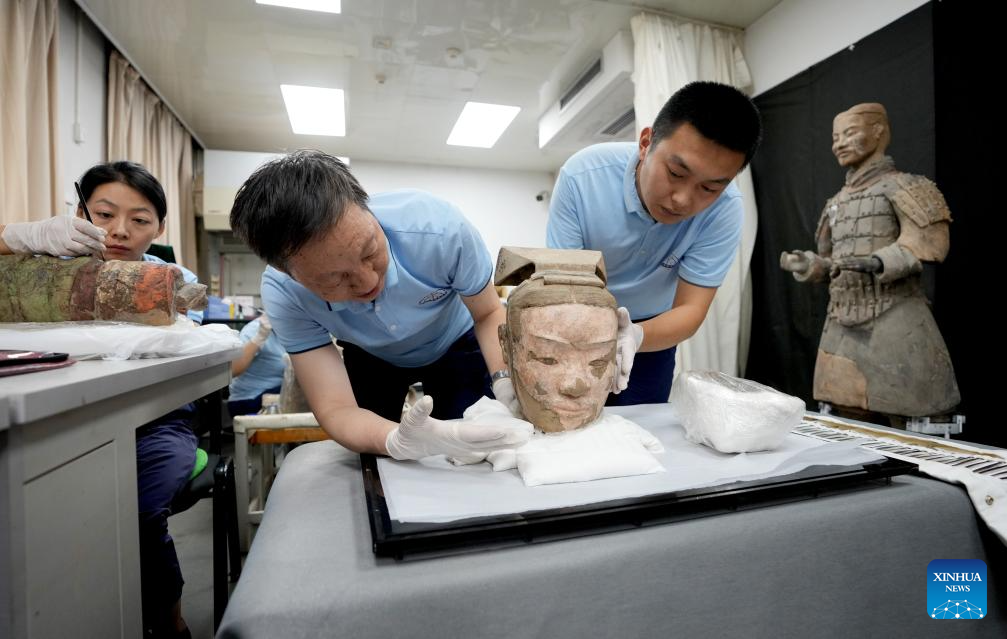
Technicians check a piece of the painted Terracotta Warrior at the Emperor Qinshihuang's Mausoleum Site Museum in Xi'an, northwest China's Shaanxi Province, Aug. 23, 2023.
"We are the Terracotta Warriors specialists, and this room is a 'hospital' for the relics in the museum," said Lan Desheng, an expert in the restoration of cultural relics with the Emperor Qinshihuang's Mausoleum Site Museum.
Archaeological research shows that pigments have been found on the Terracotta Warriors. The painted layers of the Terracotta Warriors are very fragile. Once unearthed, with the changes of humidity and temperature, the surface quickly dehydrates and the painted layer comes off. In addition, microorganisms, soluble salts and other factors also cause the color fading.
According to Lan, shortly after unearthing, each painted Terracotta Warrior must go through X-ray detection, ultrasonic scanning, 3D images acquisition and other procedures. Staff members clean and restore the pieces of the painted Terracotta Warriors using slim bamboo slips, scalpels, small brushes, etc. Every Terracotta Warrior also has its own ID. In recent years, Lan and his team have completed the restoration of more than 140 Terracotta Warriors.
Discovered in 1974 and listed as a world heritage site by UNESCO in 1987, the army of Terracotta Warriors was built by Emperor Qinshihuang of the Qin Dynasty (221 B.C.-207 B.C.). (Xinhua/Wang Yuguo)
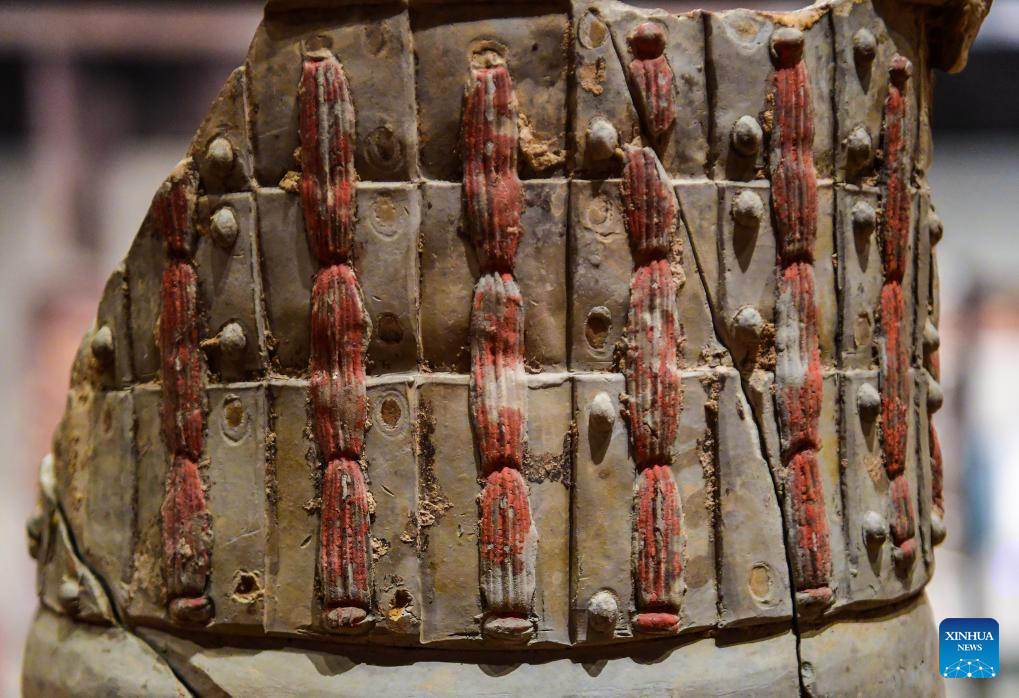
This photo taken on May 18, 2021 shows a piece of the painted Terracotta Warriors displayed at the Capital Museum in Beijing, capital of China.
"We are the Terracotta Warriors specialists, and this room is a 'hospital' for the relics in the museum," said Lan Desheng, an expert in the restoration of cultural relics with the Emperor Qinshihuang's Mausoleum Site Museum.
Archaeological research shows that pigments have been found on the Terracotta Warriors. The painted layers of the Terracotta Warriors are very fragile. Once unearthed, with the changes of humidity and temperature, the surface quickly dehydrates and the painted layer comes off. In addition, microorganisms, soluble salts and other factors also cause the color fading.
According to Lan, shortly after unearthing, each painted Terracotta Warrior must go through X-ray detection, ultrasonic scanning, 3D images acquisition and other procedures. Staff members clean and restore the pieces of the painted Terracotta Warriors using slim bamboo slips, scalpels, small brushes, etc. Every Terracotta Warrior also has its own ID. In recent years, Lan and his team have completed the restoration of more than 140 Terracotta Warriors.
Discovered in 1974 and listed as a world heritage site by UNESCO in 1987, the army of Terracotta Warriors was built by Emperor Qinshihuang of the Qin Dynasty (221 B.C.-207 B.C.). (Xinhua/Li He)
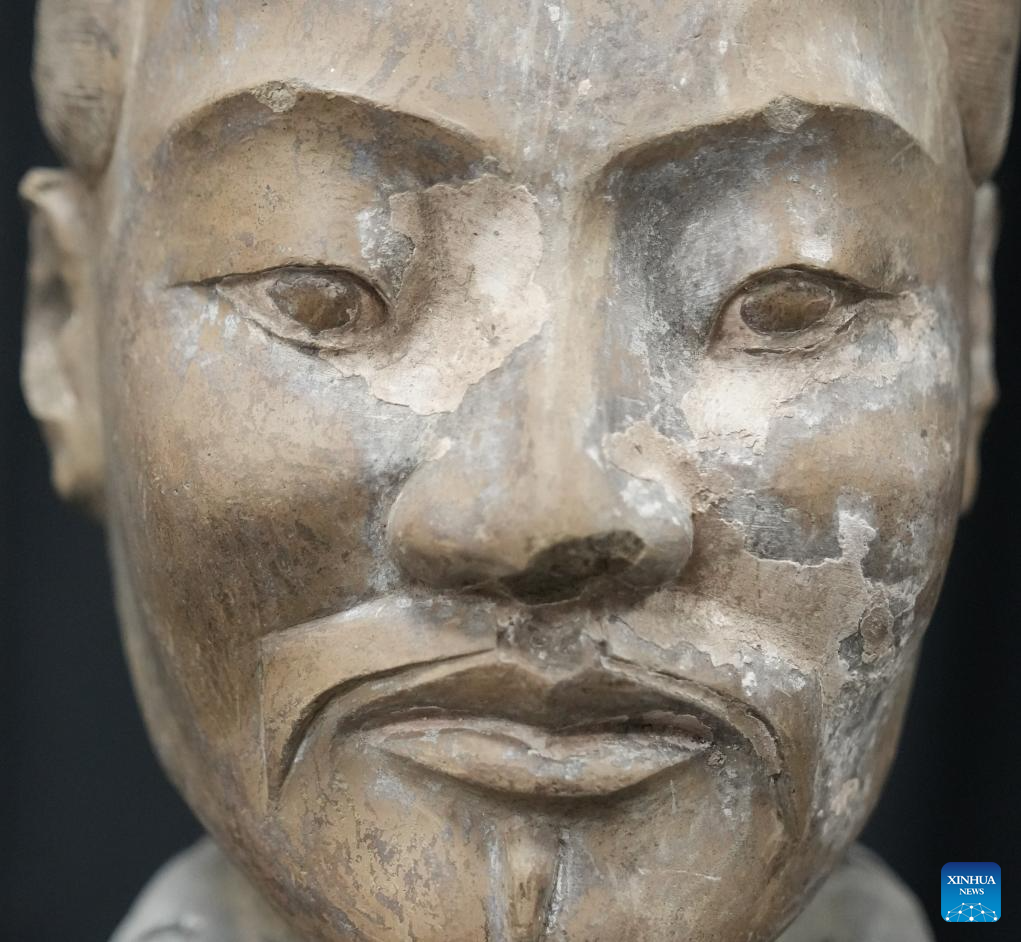
This photo taken on Aug. 23, 2023 shows a restored piece of the painted Terracotta Warriors at the Emperor Qinshihuang's Mausoleum Site Museum in Xi'an, northwest China's Shaanxi Province.
"We are the Terracotta Warriors specialists, and this room is a 'hospital' for the relics in the museum," said Lan Desheng, an expert in the restoration of cultural relics with the Emperor Qinshihuang's Mausoleum Site Museum.
Archaeological research shows that pigments have been found on the Terracotta Warriors. The painted layers of the Terracotta Warriors are very fragile. Once unearthed, with the changes of humidity and temperature, the surface quickly dehydrates and the painted layer comes off. In addition, microorganisms, soluble salts and other factors also cause the color fading.
According to Lan, shortly after unearthing, each painted Terracotta Warrior must go through X-ray detection, ultrasonic scanning, 3D images acquisition and other procedures. Staff members clean and restore the pieces of the painted Terracotta Warriors using slim bamboo slips, scalpels, small brushes, etc. Every Terracotta Warrior also has its own ID. In recent years, Lan and his team have completed the restoration of more than 140 Terracotta Warriors.
Discovered in 1974 and listed as a world heritage site by UNESCO in 1987, the army of Terracotta Warriors was built by Emperor Qinshihuang of the Qin Dynasty (221 B.C.-207 B.C.). (Xinhua/Wang Yuguo)
点击右上角![]() 微信好友
微信好友
 朋友圈
朋友圈

请使用浏览器分享功能进行分享
